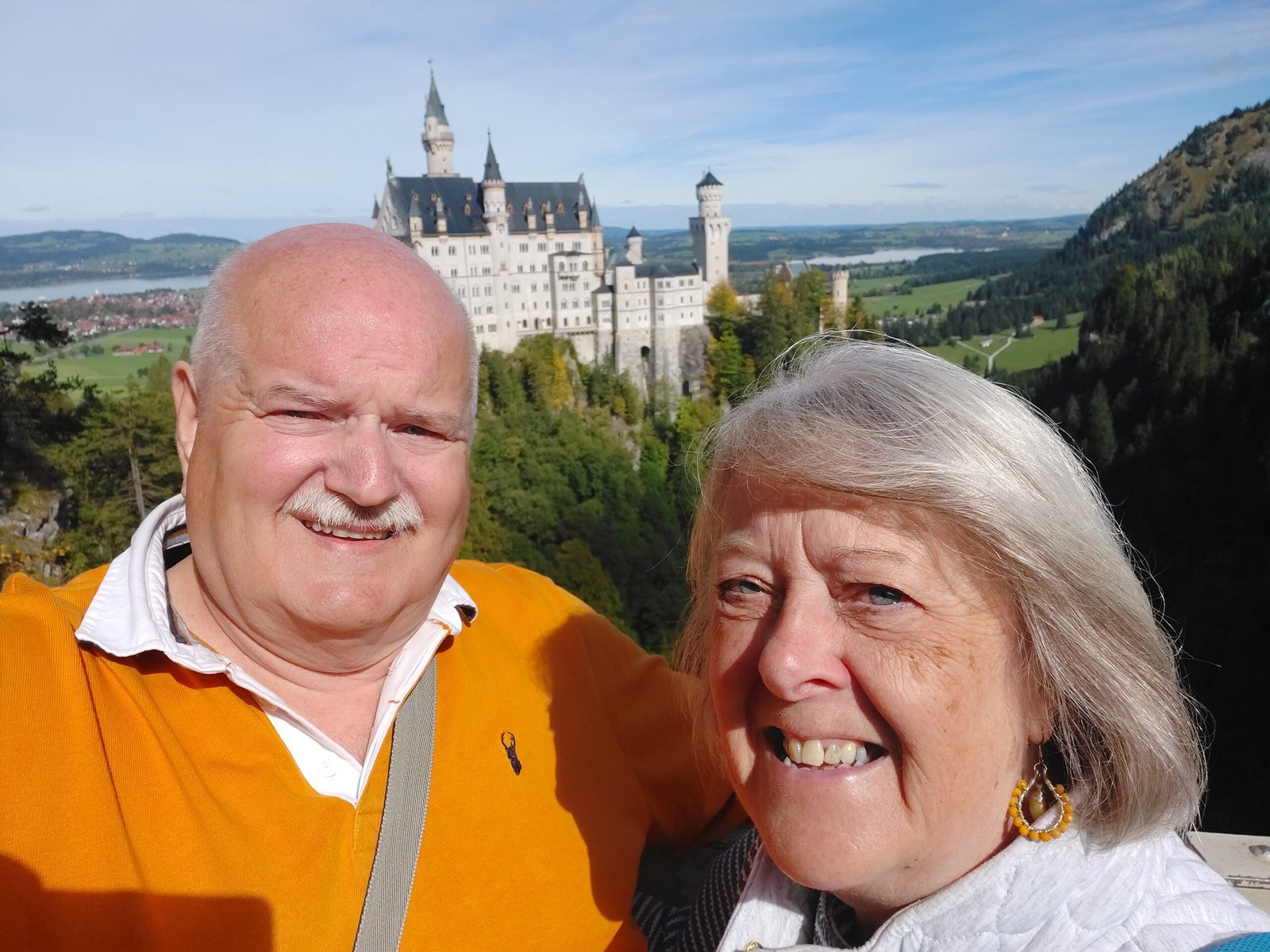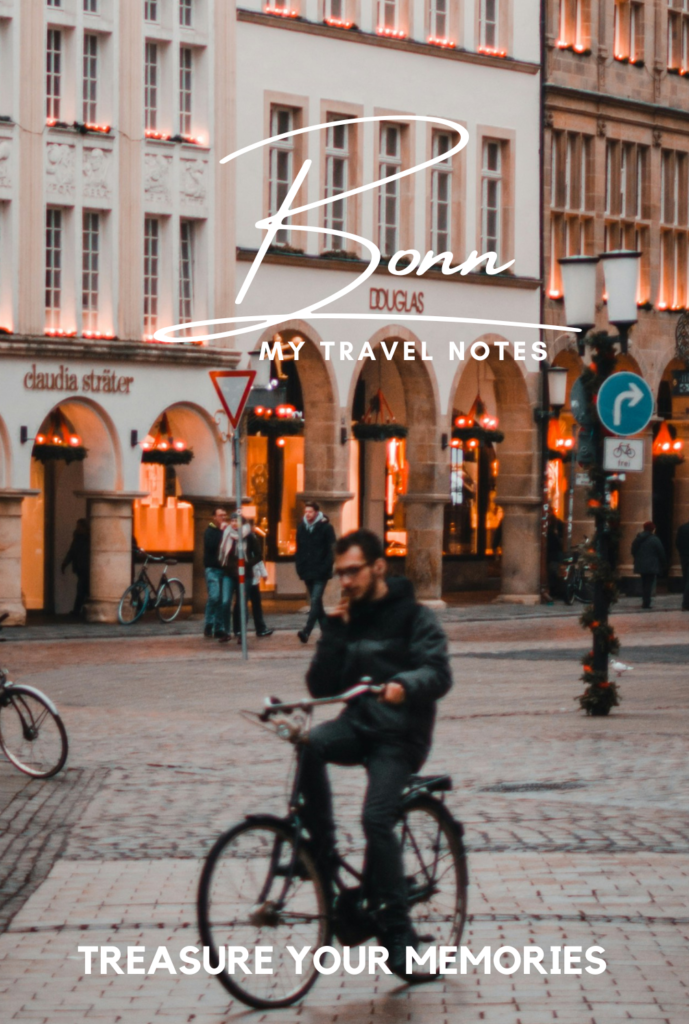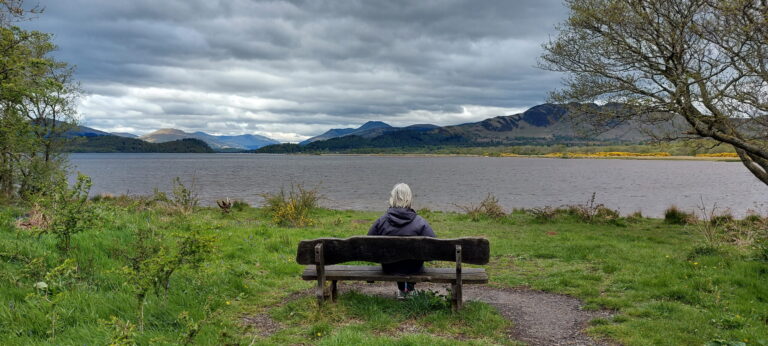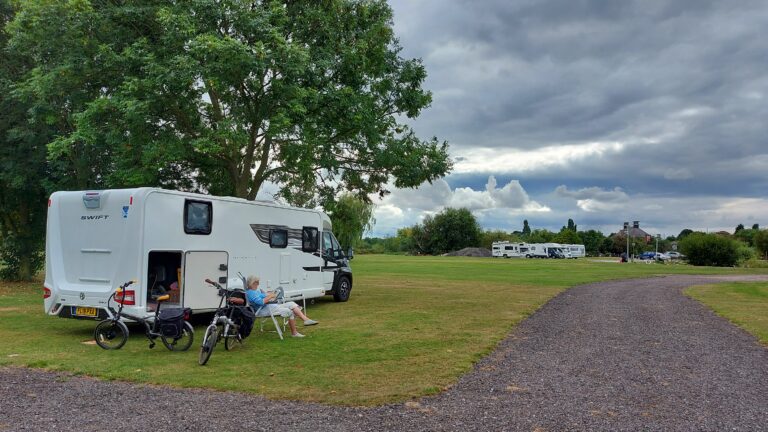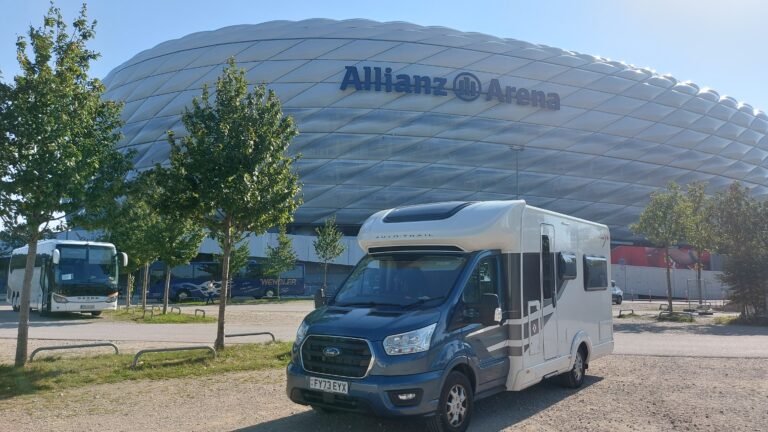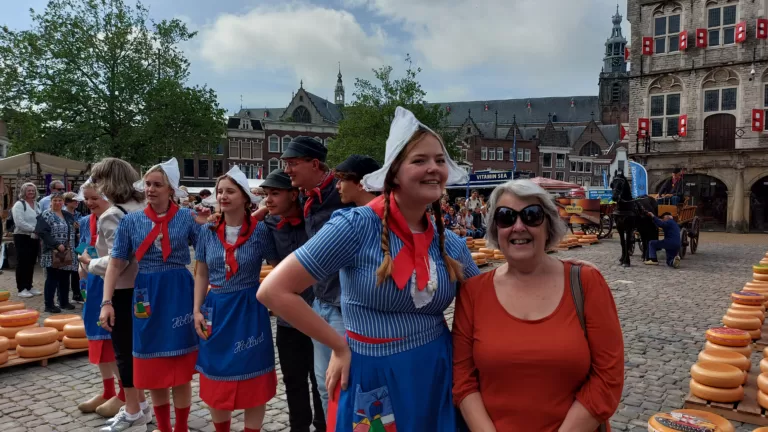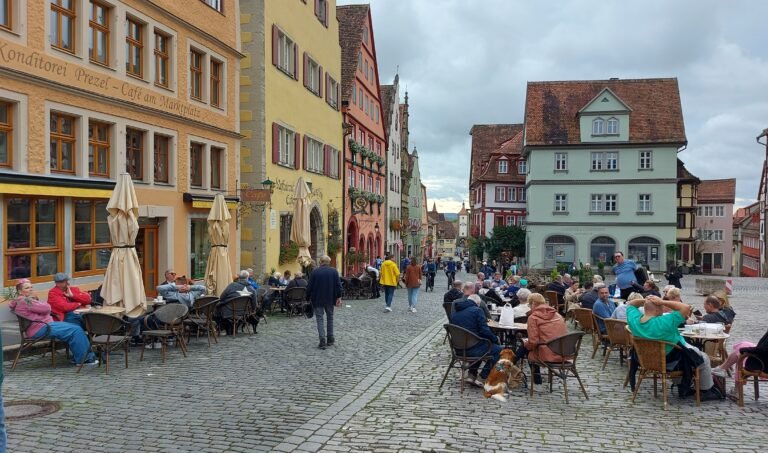ManVanNoPlan visits Neuschwasnstein Castle, Nesselwang, Schongau, Landsberg am Lech, Friedberg, Augsberg
ManVanNoPlan visits Neuschwasnstein Castle, Nesselwang, Schongau, Landsberg am Lech, Friedberg, Augsberg
Wednesday 25th of September
Neuschwanstein Castle
99.9% of people will probably drive Germany’s Romantic Road north to south, starting in Würzburg. If we had set off with the intention of driving the Romantic Road in the first place, we would have done so as well, but, as you will know from the last blog, we are on Plan B having failed to get to the Czech Republic and Austria because of Storm Boris in those countries.
The culmination of the north to south Romantic Road route is the world famous Neuschwanstein Castle, the iconic and ultimate fairy-tale castle so we start our Romantic Road journey here on a perfect sunny day for sightseeing.
“Neuschwanstein Castle is a picturesque, 19th-century Romanesque Revival palace nestled in the Bavarian Alps of Germany. Commissioned by King Ludwig II of Bavaria, the castle was designed as a personal retreat and homage to the world of medieval legends and operas by Richard Wagner, whom the king admired. Perched atop a rugged hill near the town of Füssen, its fairy-tale-like appearance has made it one of the most photographed buildings in the world.
The castle’s towers, balconies, and ornate interiors were designed to evoke the romance of chivalric ideals and Wagnerian operas. Despite its medieval look, Neuschwanstein features modern conveniences for its time, such as running water and a heating system. Though construction began in 1869, it was never fully completed before Ludwig’s mysterious death in 1886. Today, Neuschwanstein Castle draws millions of visitors each year, capturing imaginations with its storybook charm and stunning alpine setting.”
The first bus picked us up on time from near the Stellplatz and took us into Füssen bus station along some narrow streets in the town, for such a long bus anyway. We then hopped onto another bus to Neuschwanstein Castle, again for free, and were there in about fifteen minutes. Where we were dropped off gave us the first glimpse of the castle and immediately you are struck by how impressive and imposing it is.

This view is from below the castle, but of course the best views are from above looking down on it. To do that you walk another two hundred yards and get on yet another bus which takes you up the mountain to a spot fairly close to the Marienbrücke Bridge. The cost is € 3 up or € 3.50 return and its the best € 7 we have spent so far, although we did end up walking down later on.
The first place everyone heads for on leaving the bus is the Marienbrücke, the famous bridge built in 1886 over the Pöllat Gorge where everyone seems to takes a million pictures and selfies, including me!
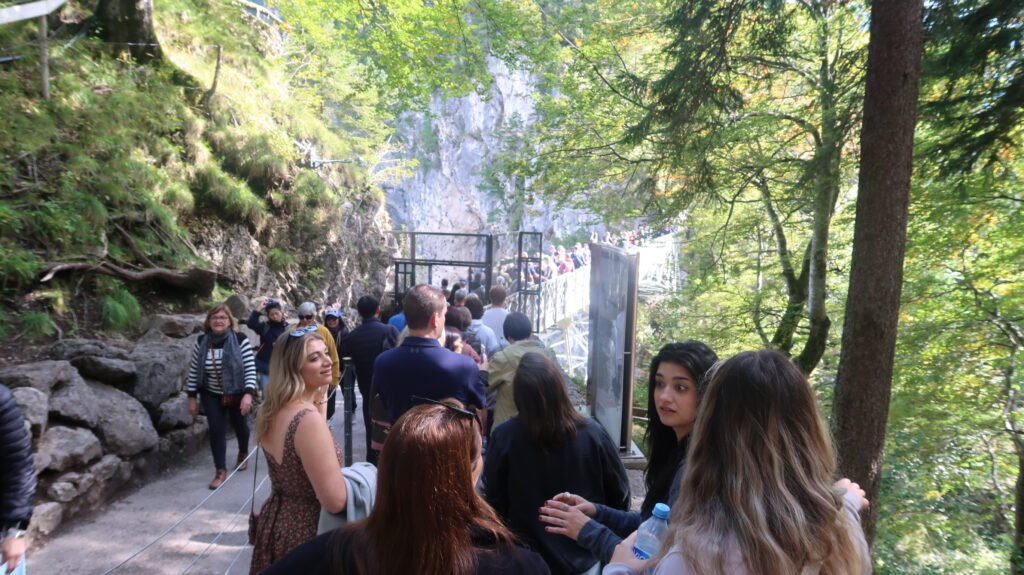
The height over the gorge must be 200 feet and The Navigator did well to stand on it for so long, given her fear of heights. We were in the second of two buses that arrived at the same time and so we had to queue for a few minutes to get on the bridge, which, with all the people on it at the same time, was a bit wobbly!

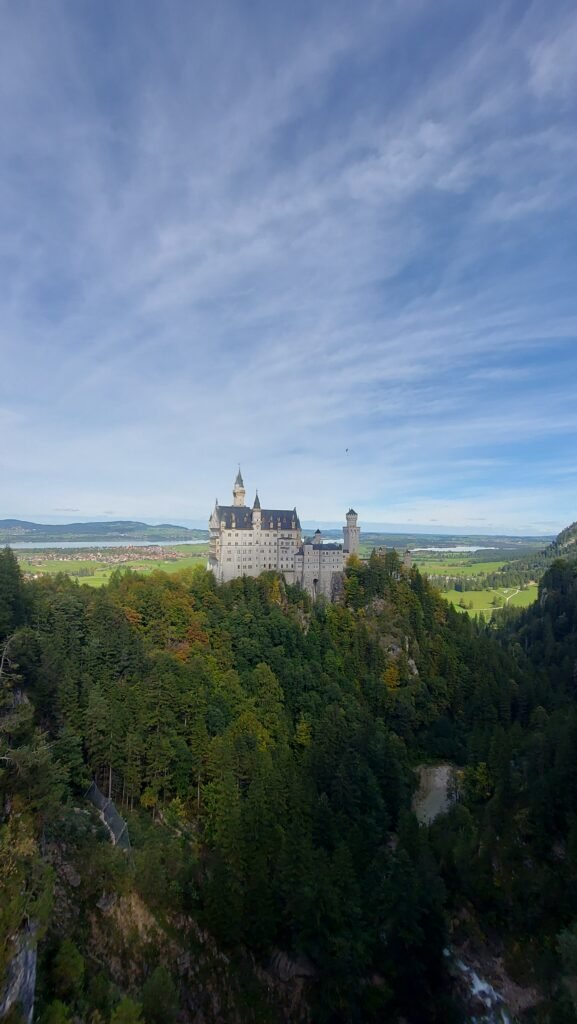


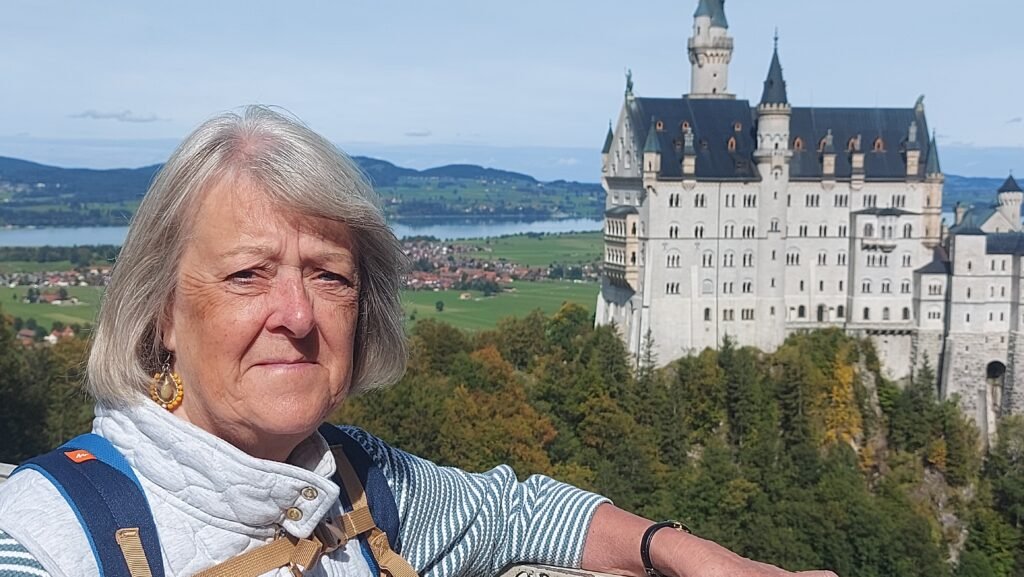
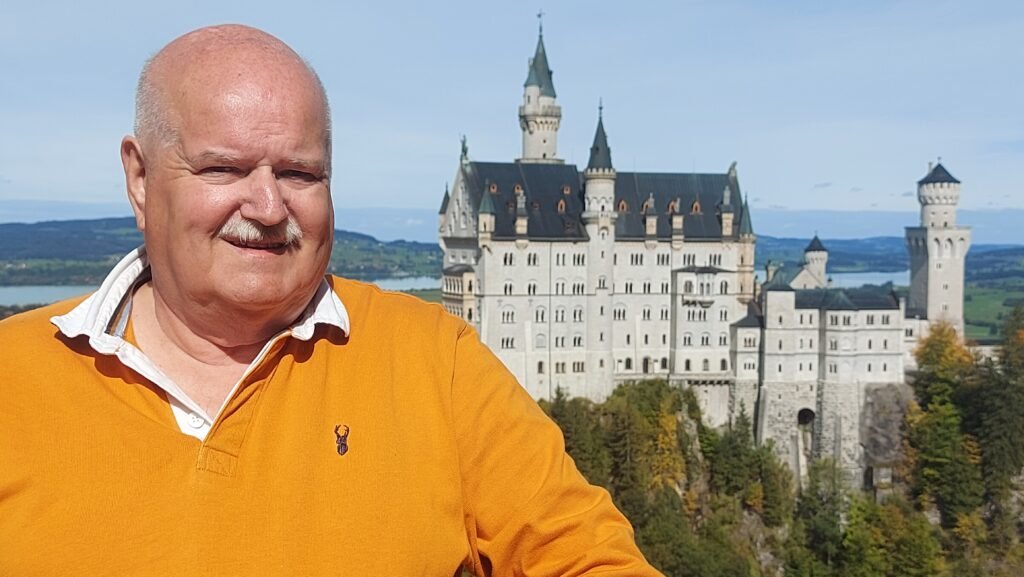

You can go on from the bridge and walk further up into the mountains, but after walking a hundred yards or so we felt it was too dangerous for we tourists without the proper hiking gear. When we got back to the bridge there were far fewer people on it so we stood for a while taking in this incredible view.


It is said 1.6 million people a year visit the castle from all over the world, with many thousands a day making the effort to stand on this bridge. From the bridge you walk downhill towards the castle, with a stop at another amazing viewpoint which looks over another impressive castle, Schloss Hohenschwangau and the mountain and lakes behind it.
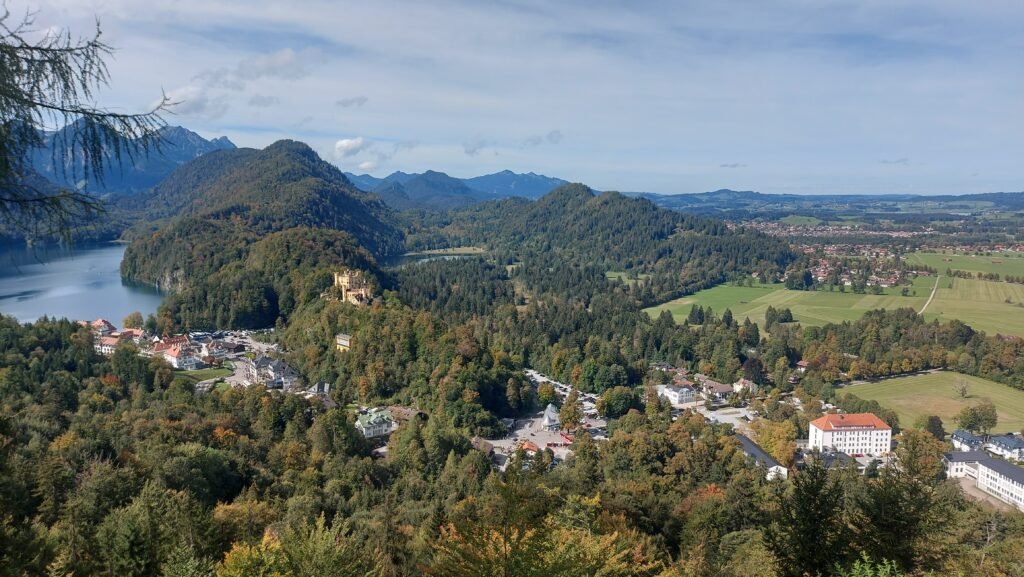
“Schloss Hohenschwangau, nestled in the Bavarian Alps near Füssen, Germany, is a 19th-century castle known for its romantic charm and historical significance. Built on medieval foundations, it was reconstructed in neo-Gothic style by King Maximilian II of Bavaria, serving as the royal family’s summer residence. The castle’s yellow facade, turreted architecture, and sweeping alpine views create a fairytale-like atmosphere. Inside, richly decorated rooms feature murals inspired by medieval legends and German history, offering insight into Bavarian culture. Notably, King Ludwig II spent much of his childhood here, drawing inspiration for his later creation of the iconic Neuschwanstein Castle nearby.”
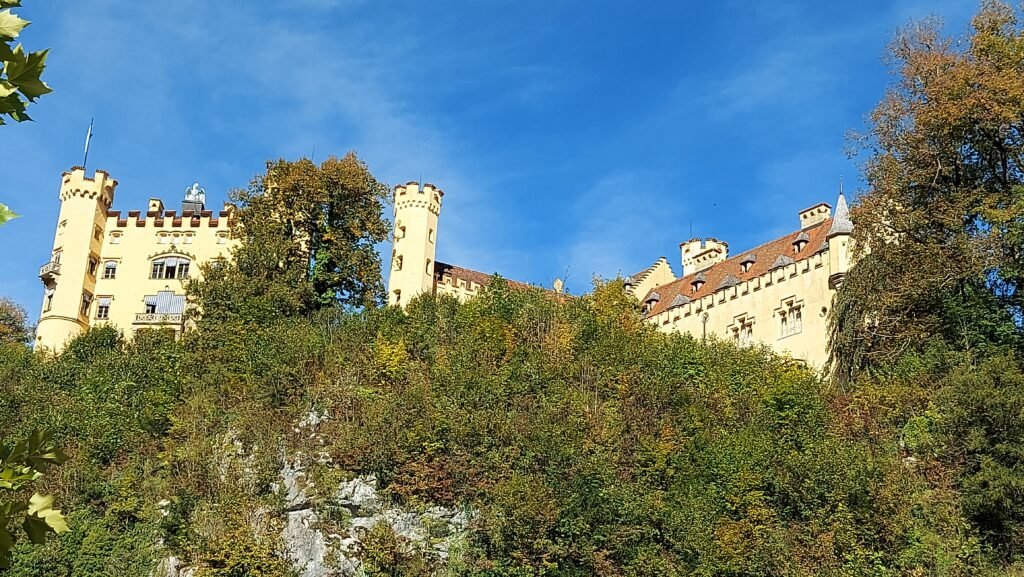
At the viewpoint an American tourist (there were loads of them here) took a few pictures of us. Another few hundred yards downhill takes you to the entrance of the castle, which we decided not to visit. Because Ludwig II only lived in the castle a few months before he died in mysterious circumstances, there are no great rooms or treasures to see and you only get to enter three rooms so we passed on an internal visit.

It was on the walk down to the castle that we decided not to take the bus back and continue walking down to the village as to return on the bus you would have to walk up the very steep slope and as we descended we could see some of the people going uphill were in a bit of a state!
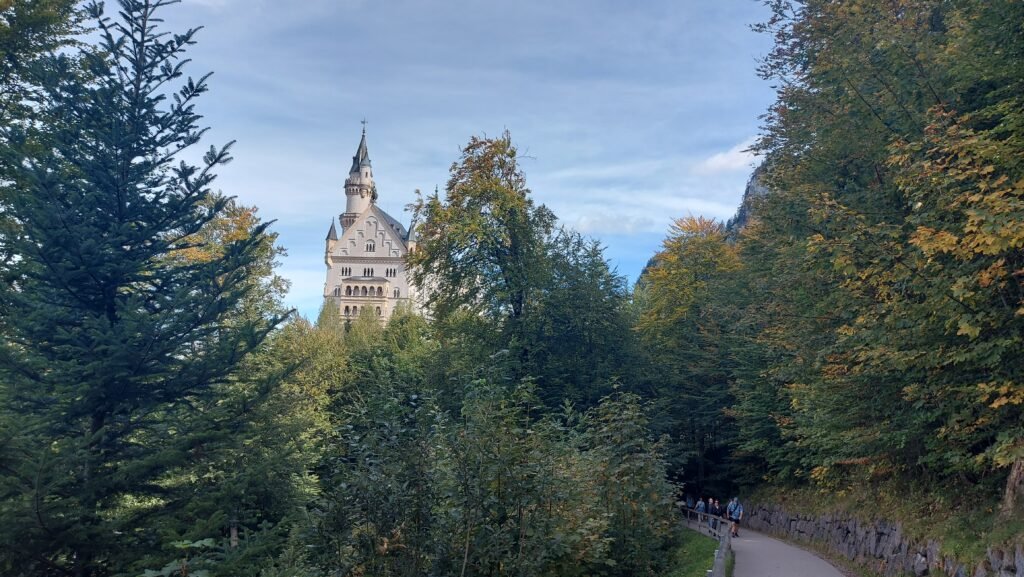
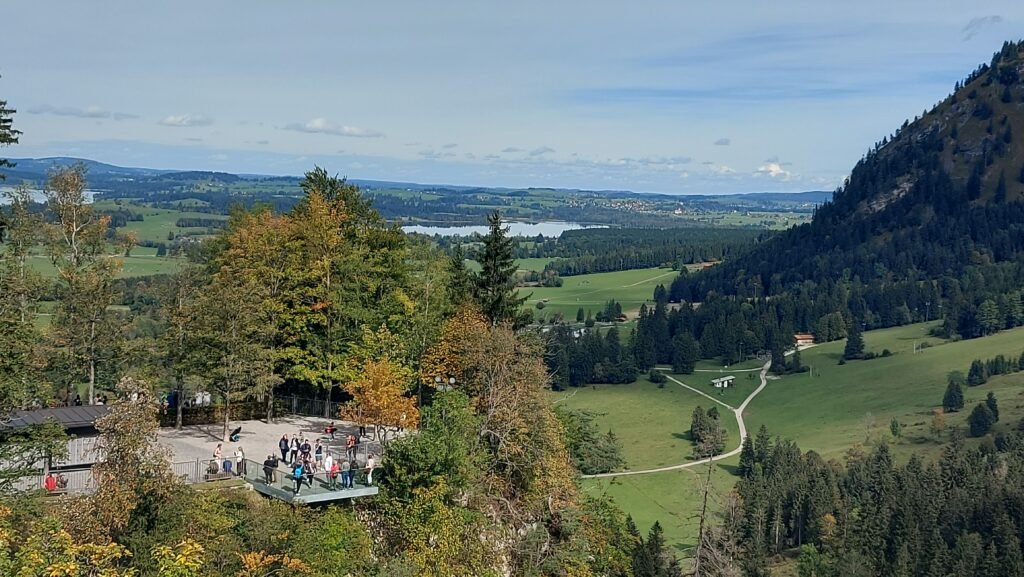
There is another viewing platform where on one side you see the front entrance of the castle which is the opposite side from the view from the bridge. On the other side of the viewing platform you look down to the flat plain below. The Navigator had packed a picnic so we sat and enjoyed it surrounding by a coachload of American college students and all I can say is, if this is the calibre of American youth on offer, then America is doomed!


We set off to walk down what must be just over a mile on a road shared by horse drawn carriages and thankfully for the horses, the carriages are power assisted. Most are full with fourteen people paying € 8 a pop to go up and € 4 to go down so a round trip earns the driver € 168 for about an hours work.
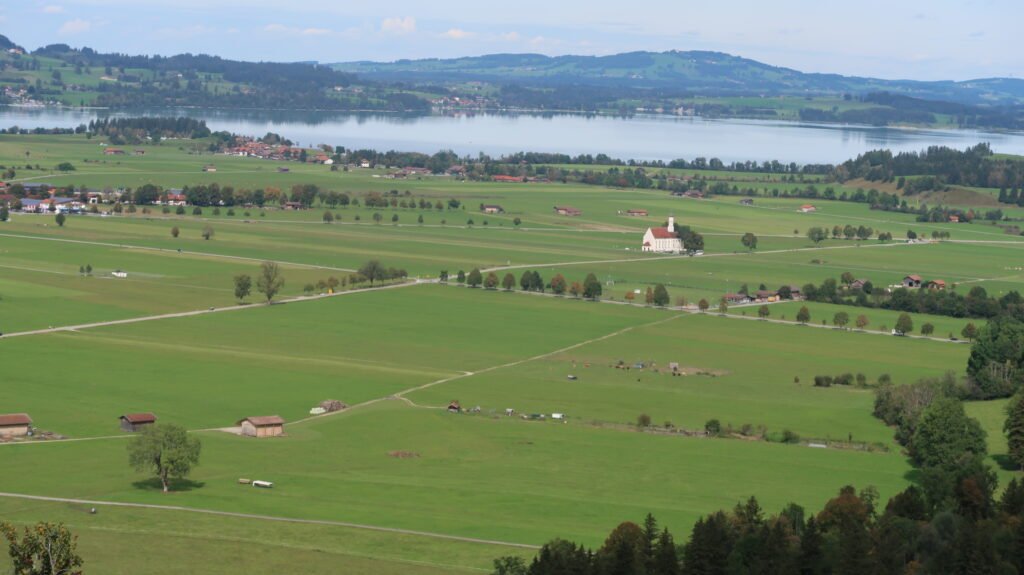

Many people were making the effort to walk up, either because they enjoyed suffering or were too stingy to take the bus and the ones we really felt sorry for were a bus load of elderly Asians being marched up the very steep hill by a young fit guide carrying a flag on a stick.


Down at the bottom we had to queue for the best part on an hour before a bus turned up to take us back to Füssen, standing all the way, where we then had to wait for ages for a bus back towards the Stellplatz. All in all we walked 7,500 steps today, half of what we’ve walked on other days but my feet and legs were feeling the effort tonight. Later on the Navigator made use of the washing machine and dryer and after dinner we walked across the road to Lidl as were are off tomorrow to head up the world famous Romantic Road….
Thursday 26th September
Füssen to Nesselwang (47.619499,10.498097)
After a day in Füssen and a day at Neuschwanstein Castle it is time to move on again. Füssen, which is only one kilometre from the Austrian border, has been the most southerly point on this tour and we start to head north again, not that we are in any hurry to get to a ferry port as we still have nearly five weeks before heading home.
Füssen marks the end (or beginning) of what is known as the Romantic Road between Würzburg in the north and Füssen in the south. Our circular route to get here means that Füssen is our starting point and we will head north. Having said that, we will be deviating off the road to see some historic and interesting towns and villages along the general northwards route and the first of those is Nesselwang, which is all of 25 minutes away so there was no need to be on the road too early.
“Nesselwang is a charming village in Bavaria, Germany, nestled in the foothills of the Allgäu Alps. Known for its picturesque landscape, the town offers scenic views, lush meadows, and traditional Bavarian architecture. It’s an ideal destination for outdoor enthusiasts, with hiking trails, mountain biking, and the Alpspitzbahn, a cable car that takes visitors up to panoramic mountain views. In winter, Nesselwang becomes a popular spot for skiing and snowboarding. The town is also rich in cultural heritage, with landmarks like St. Andrew’s Church, colorful festivals, and cozy alpine inns, making it a perfect blend of natural beauty and Bavarian tradition.”
As I entered the village I missed the turn into the street the Stellplatz is on and had to carry on and up out of the village before I could turn around. As it happened there was a layby on the hillside so was able to stop and take this picture of the village and the Alps in the distance.

We were on our pitch before 10am and relaxed until lunchtime. The Stellplatz was busier than I expected as this is a fairly small sleepy village and out of season, which, as a ski resort, is obviously through the winter. Beside this brand new Stellplatz is the ski slope, which although working, had no one travelling on it.

After lunch we walked into the village which is dominated by a church. The shops were mostly closed apart from a couple of bakers and an Aldi which was doing good business. After a lap of the village we headed back to the van as it was threatening to rain and were surprised to find a Welsh couple had arrived when we were away and we had a chat with them for a while until the rain became too heavy to stand outside. They had been as far as the heel of Italy, and like us, were heading north at a similarly slow pace. Kites circled overhead and we also saw a black squirrel at the foot of a tree near us.
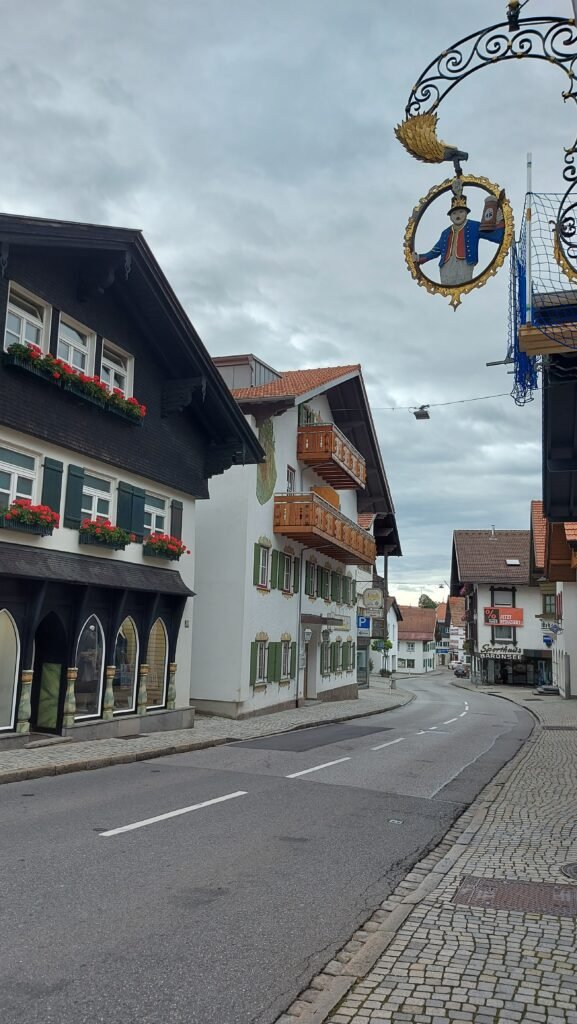


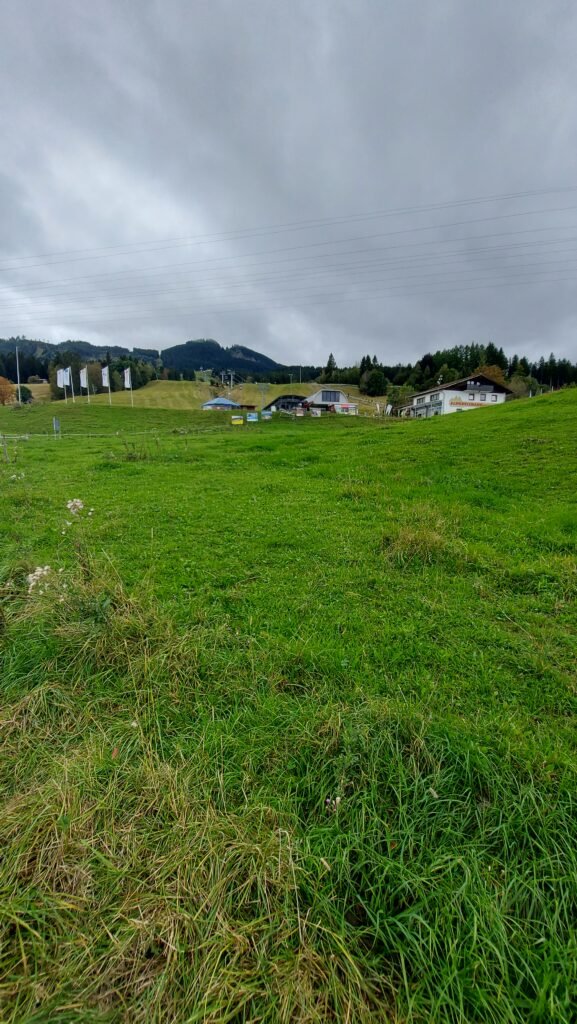

I may be doing my own country down unfairly, but I’m not sure how long a vending machine full of expensive spirits, beers and local artisan products would last before being vandalised…
Friday 27th of September
Nesselwang to Schongau (47.809051, 10.898742)
“Schongau is a historic town in Bavaria, Germany, located along the scenic Romantic Road. Surrounded by well-preserved medieval walls, Schongau’s old town features narrow cobblestone streets, charming squares, and traditional Bavarian architecture. Its prominent landmarks include the Church of the Assumption, with its striking baroque interior, and the town’s ancient gates and towers. Perched on a hill overlooking the Lech River, Schongau offers beautiful views of the surrounding countryside. The town’s rich history dates back to Roman times, and today it provides a peaceful, picturesque setting for visitors exploring Bavaria’s cultural and natural heritage.”
We were actually going to visit a nearby town called Kempten but the Stellplatz there only catered for six vans and, as the chances of there being a space were slim, thought better of it. The Stellplatz at Nesselwang ended up being full last night and we had the misfortune to have an inconsiderate Italian numptie park beside us at about 9pm.
After he reversed in to the space we could hear him talking quite loudly which was strange as it was raining heavily. After a while I went to the door to pull down the blind to see what was going on to discover he had put his awning partially out with the outside light on and he was standing there smoking. What I didn’t see until the morning was that he had erected a satellite dish on a tall tripod and must have been talking loudly to his wife to check on whether the TV was receiving a picture.
He saw me staring at him and went inside his van. Later at about 11.30pm the loud talking commenced again so with blood boiling I opened the door in my jim jams to shout at him to pack it in. He was actually smoking in his van now but with the door open with either his talking or the noise of the TV was keeping us awake. This is the problem when a UK van and a foreign van park side by side as the doors face each other. My shouting at him did the trick and there was no more noise.
There are idiots in every country but also lovely people as well and a German couple opposite us came over to talk to us when we arrived and left. After servicing the van we set off through some very pretty manicured countryside and arrived in Schongau an hour later.
After leaving a Stellplatz packed with about thirty vans, there were only three here, and one of them drew away just as we arrived! I thought we would stay two nights here as it was only € 8 but only paid for one night initially.

After lunch we headed off to visit the town centre which turned out to be a bit of a trek, as rather than tackle the near vertical steps up to the town, we went for a more gradual circular route which was much longer, but nowhere near as steep. The town centre was quite pretty, as most German towns are, with individual local shops rather than the usual national chains, but it was much smaller than we thought it would be. The town looks quite big on the Google satellite view but took us less than an hour to walk about it.

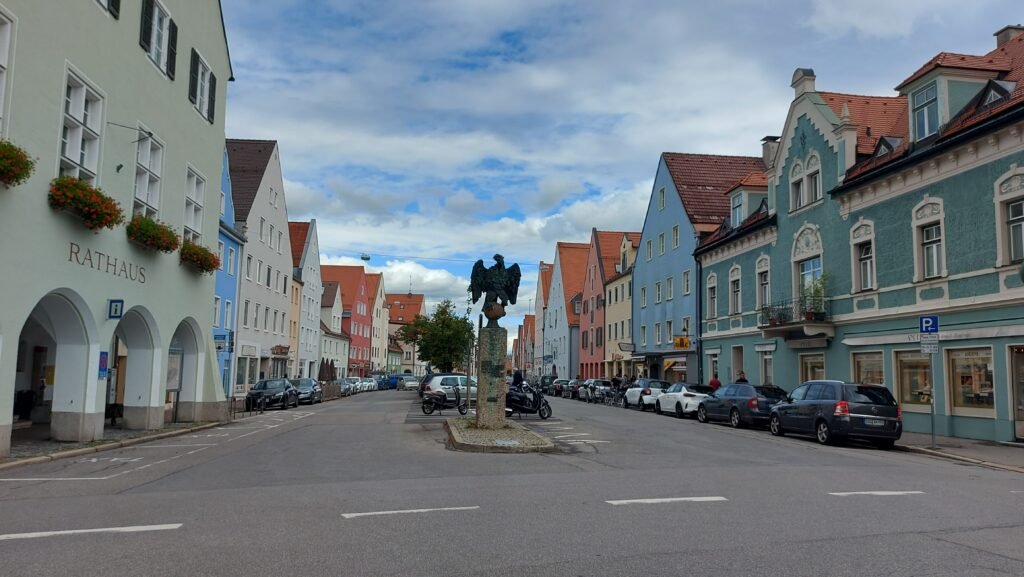
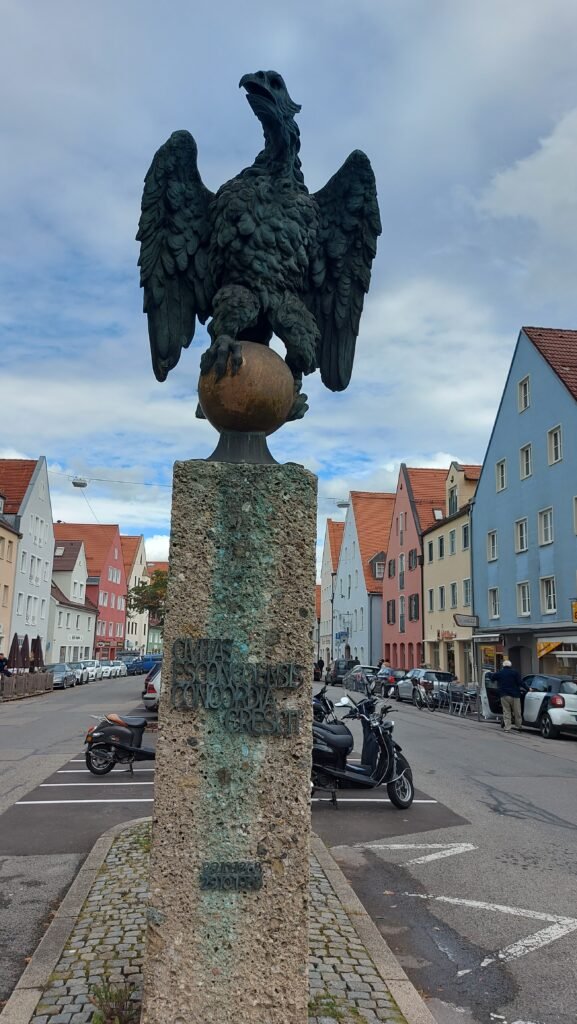
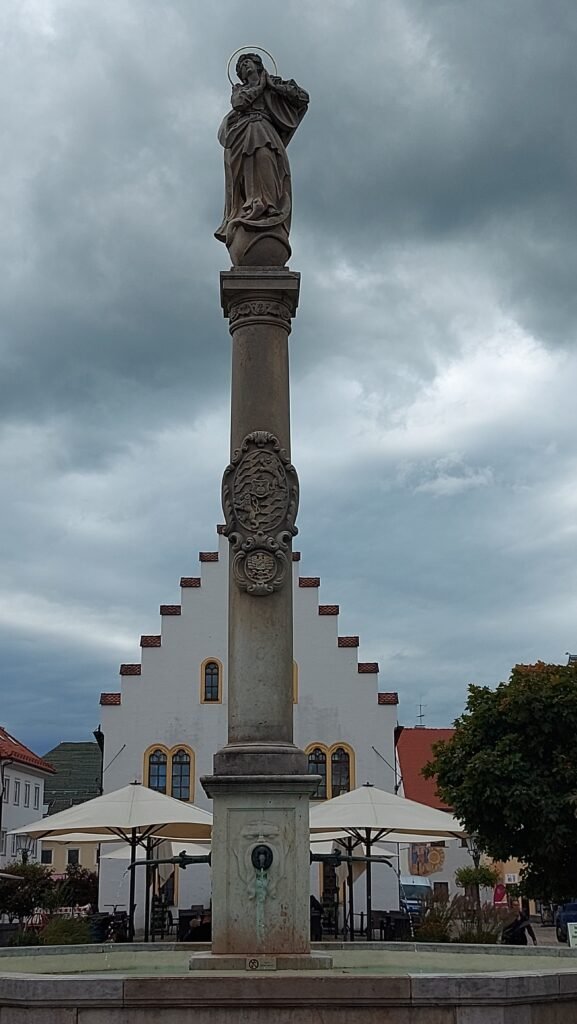
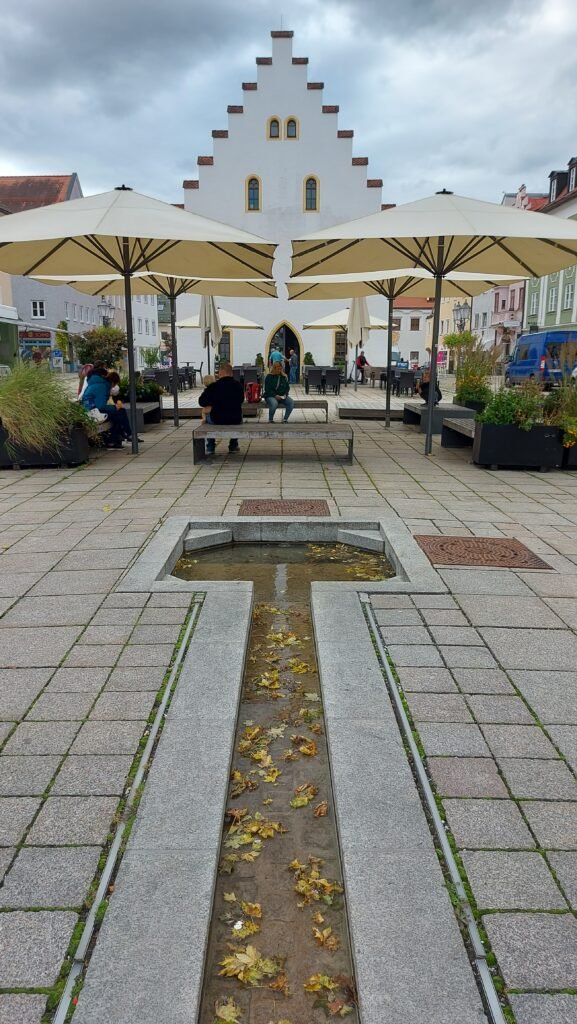
There was a white tower at the end of the main street and we went to have a look at it to discover it was one of the original defensive watchtowers with a pathway on the other side which circled the town. We were actually a couple of hundred feet above the van at this point although we couldn’t see it for trees.

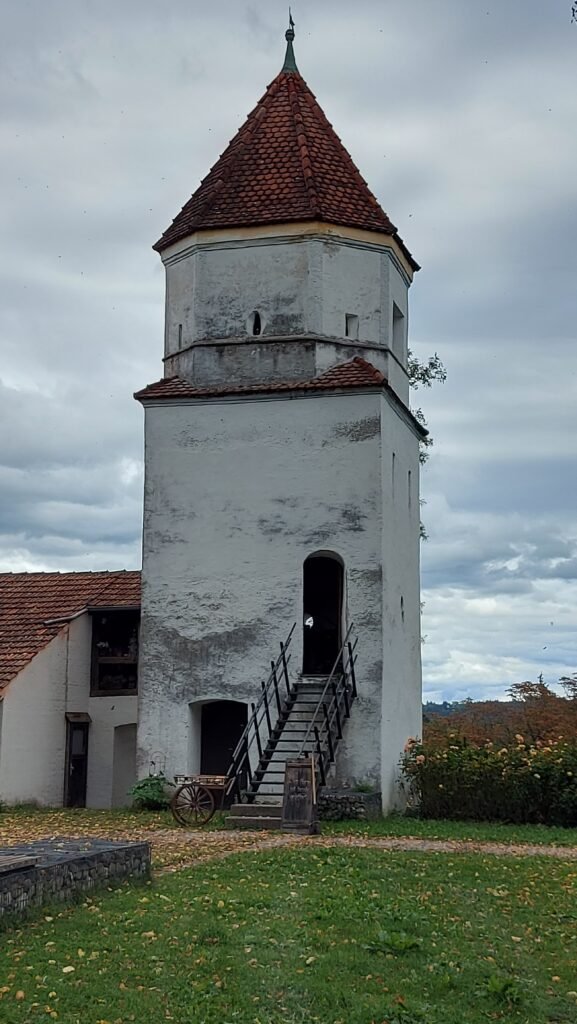
As we walked around the path we came to another ancient white tower and this one was open so curiosity got the better of me and I climbed the steps and went inside to discover an eclectic mix of stuffed animals and ornaments. I could hear someone walking about upstairs and eventually a woman came down the very steep stairs and it turned out this was the owner, Ursula.
By this time The Navigator had reluctantly joined me and we chatted to Ursula who was dressed in an unusual costume. She insisted we go and look upstairs and on the next landing we saw a collection of bottles that Ursula claimed were herbal remedies that she had concocted. The next landing had even steeper steps up to it and The Navigator declined the invitation to go up any further as she was concerned she may not get back down again!

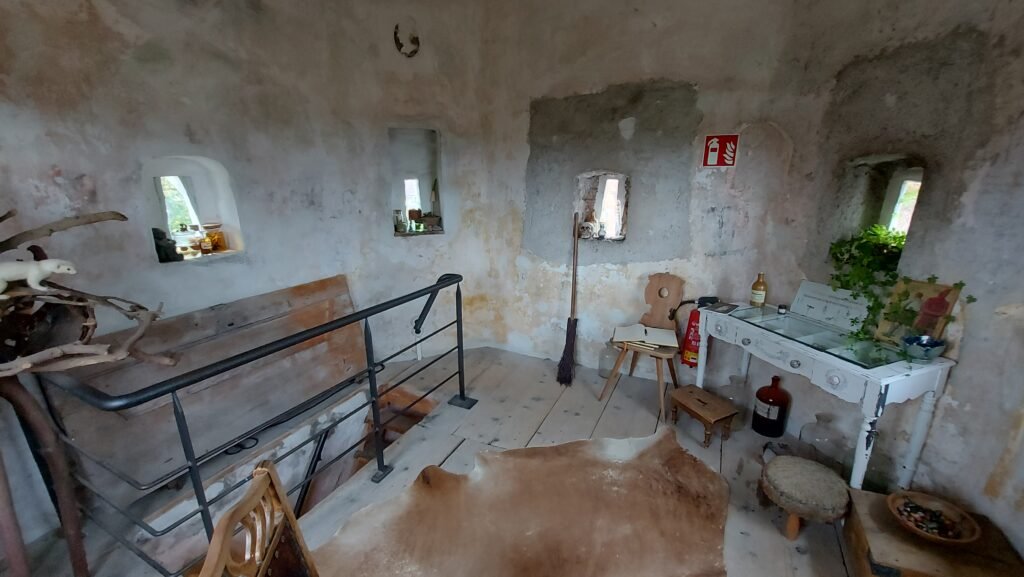
I went up on my own and left The Navigator explaining to Ursula that she was not too good with heights to which Ursula offered one of her potions which would cure her of this phobia, but The Navigator graciously declined. I left € 5 in a bowl as a tip for her time and invitation to see her tower and we left to continue our rampart walk with The Navigator debating whether Ursula may have been just eccentric or some sort of witch, if there is such a thing nowadays.

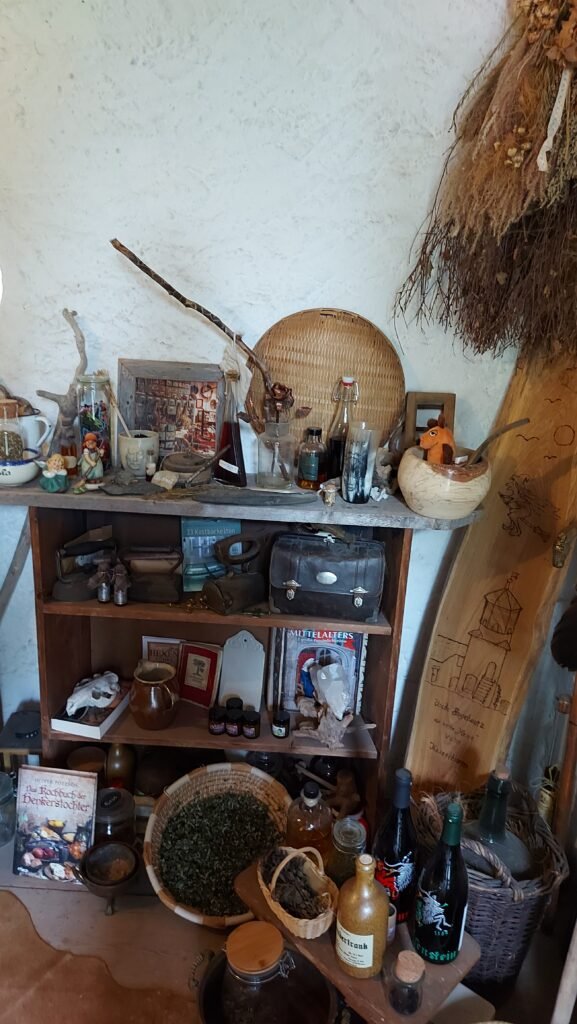


We took the steep steps down to where Otto was parked and settled down for a lazy afternoon as the rain came on quite heavily. We were joined by a few other vans, including another Brit next to us.
Saturday 28th of September
Schongau to Landsberg am Lech (48.056143, 10.872696)
We are parked next to the river Lech and our next destination is also on the Lech as you would gather by it’s name. Saturday is not our favourite day to move on but we had seen all we wanted to see in Schongau so it was worth the short move to Landsberg am Lech. The rain had been lashing down all night and was still going strong as we woke up.
It was only meant to be a half hours drive but Google managed to take us on a circular route around Schongau before we slipped onto the A17 heading north, the road that is the spine of the Romantic Road. The Stellplatz at Landsberg is a motorhome designated part of the town car park with electric and all the other facilities, and for € 5 a night it is a great value with the electric another bargain at € 1 timed for six hours.
“Landsberg am Lech is a picturesque town in Bavaria, Germany, located along the Lech River and the famous Romantic Road. Known for its well-preserved medieval architecture, Landsberg boasts an enchanting old town with colorful facades, cobblestone streets, and charming squares. One of its most iconic landmarks is the 15th-century Bayertor, a grand city gate with intricate details that reflect the town’s rich history.
The town center is dominated by the Church of the Assumption, with its baroque interior and ornate frescoes. Landsberg’s scenic riverside location adds to its appeal, with the Lech River cascading over the Lechwehr weir, creating a dramatic backdrop. Visitors can stroll along the riverbanks or explore the town’s many cafés and local shops.”
It was 10.30am as we were leaving the Stellplatz to walk the short distance to the bridge over the Lech and through the ancient gateway to the town. The weather was a bit iffy and it would turn out to be the first day of this whole trip that we had to contend with rain showers when we were out and about during the day. The town was bustling with both pedestrians and vehicles and we found some market stalls in the main street and square.
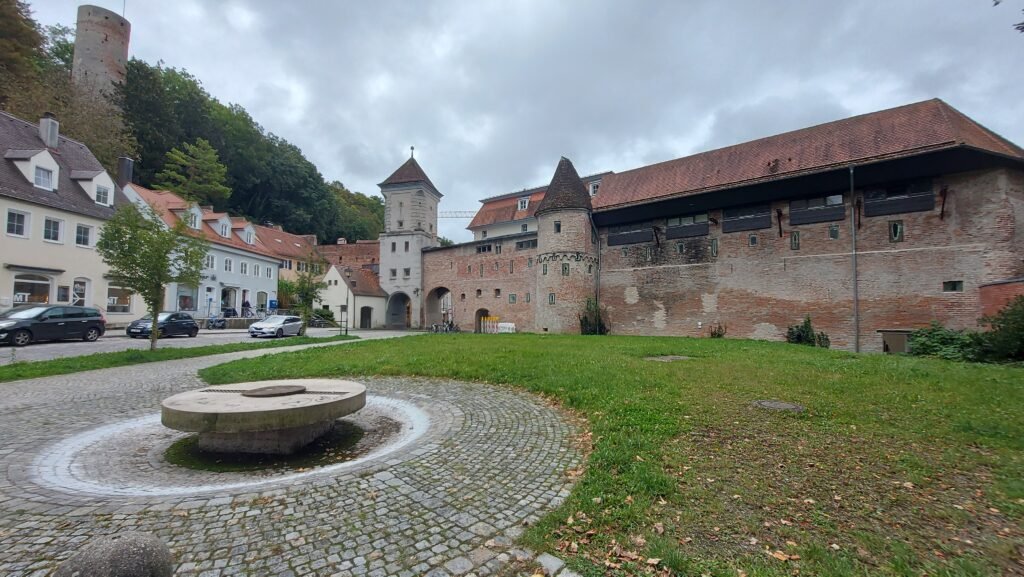
At one point we had to cross the main road and a young woman in a small car stopped and motioned for us to cross in front of her, which we did, only to hear a metallic crunching noise as the car behind banged into the rear of the woman’s car. Luckily, the traffic was crawling but it was obvious the man in the second car was not paying attention. The Navigator was for legging it as it was not our fault and the language barrier would have been an issue so we walked on after seeing them amicably exchanging details!

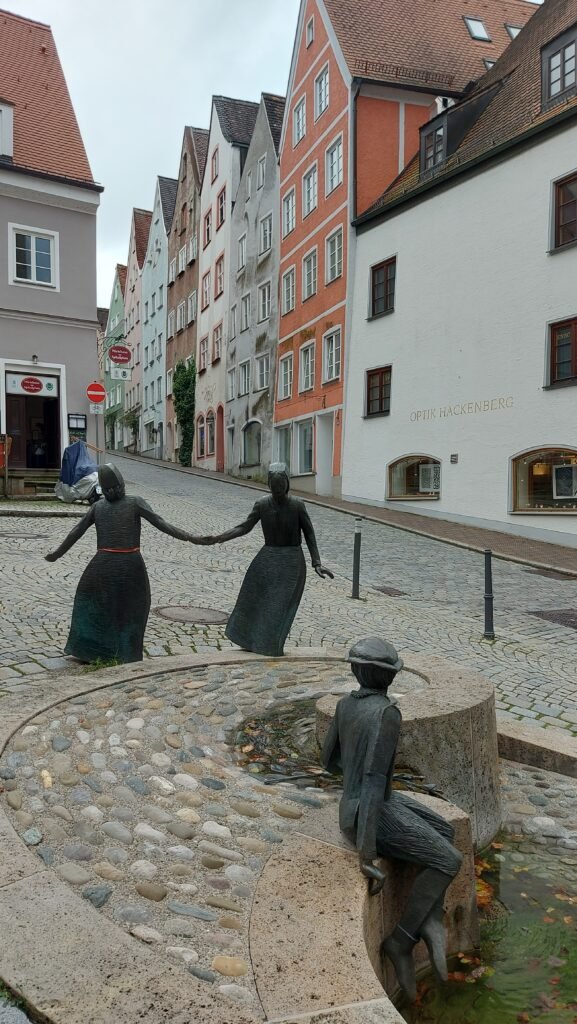
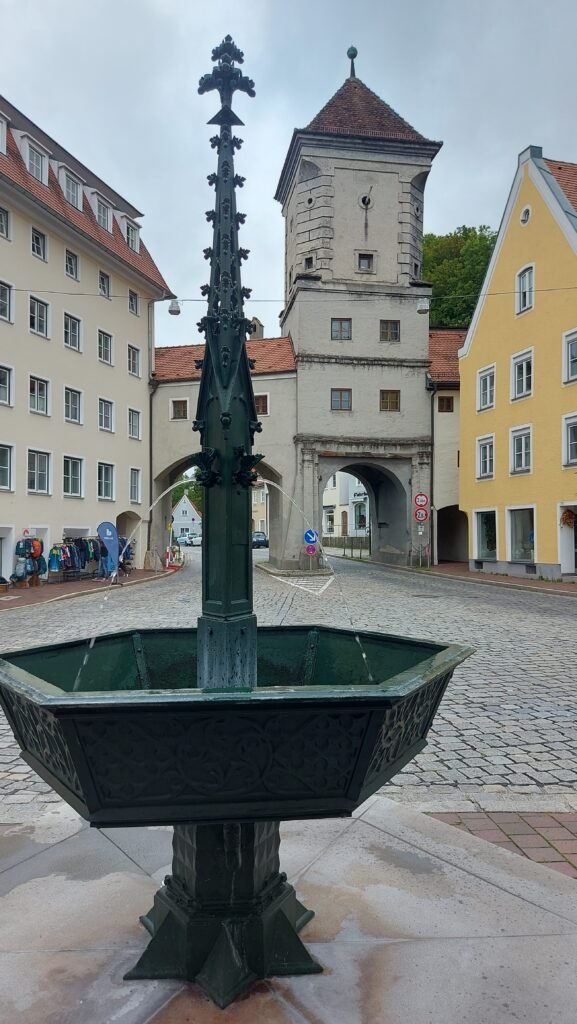

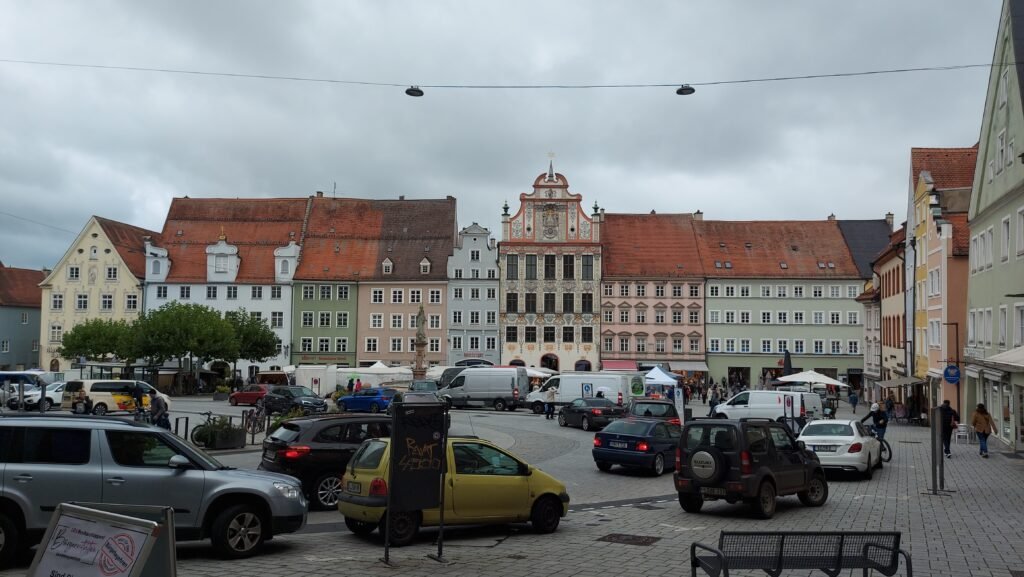
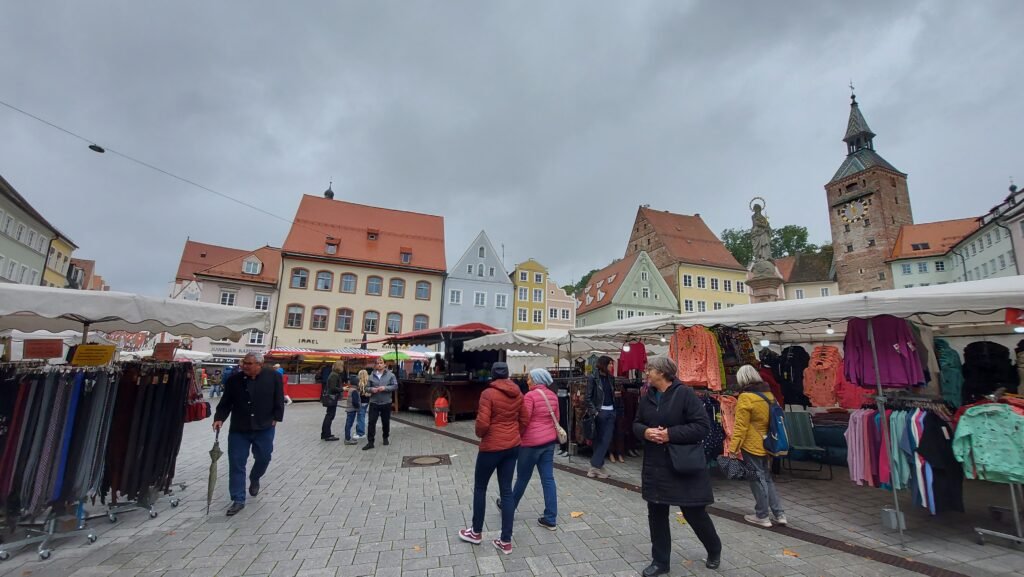
Landsberg am Lech is yet another town we had never heard of, but it is steeped in history and has some amazing buildings and an incredible church. It was during a particularly heavy shower that we took sanctuary inside and what a magnificent and richly decorated building it was.
“The church, first mentioned in 1179, and was updated in the late Gothic style between 1458 and 1488. Unlike most contemporary churches in the Duchy of Bavaria, the church does not follow the plan of a hall church, but rather a three-aisled pillar basilica with a high central nave and lower side aisles. The building material was bricks and the exterior with the portals still shows a mainly late Gothic appearance. The mighty, broad Gothic church was given a Baroque makeover from 1678 onwards. It was given a magnificent interior, such as the altars, the pulpit, the organ facade and a large number of sculptures around this time.”

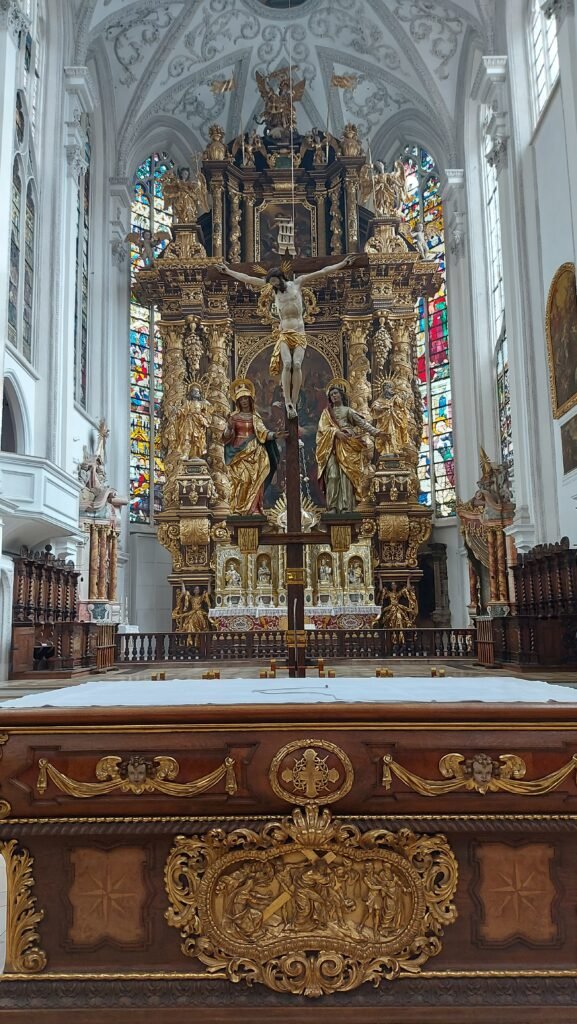

A deep font with a small fish fountain on the surface of the water was unusual to see but the end wall was decorated in gold carving to a very high standard as was all the statues fixed to the pillars. Just before we entered the church a large number of people came out so there probably had been some sort of ceremony that morning which must have used copious amounts of incense as, although a huge building, there was a hazy atmosphere inside.
Another intriguing sight near the front was a rose hip bush with an abundant amount of rose hips and painted eggs hanging from the branches as you would see at Easter, but this was the end of September. Seeing this bush with so many rose hips on it reminded me of my primary school days when the whole school, about thirty odd of us, were marched to a nearby disused railway line to pick rose hips by the sack full which we were told would be sent off to make Delrosa Syrup and I remember my mother buying it and spooning copious amounts of it into me…

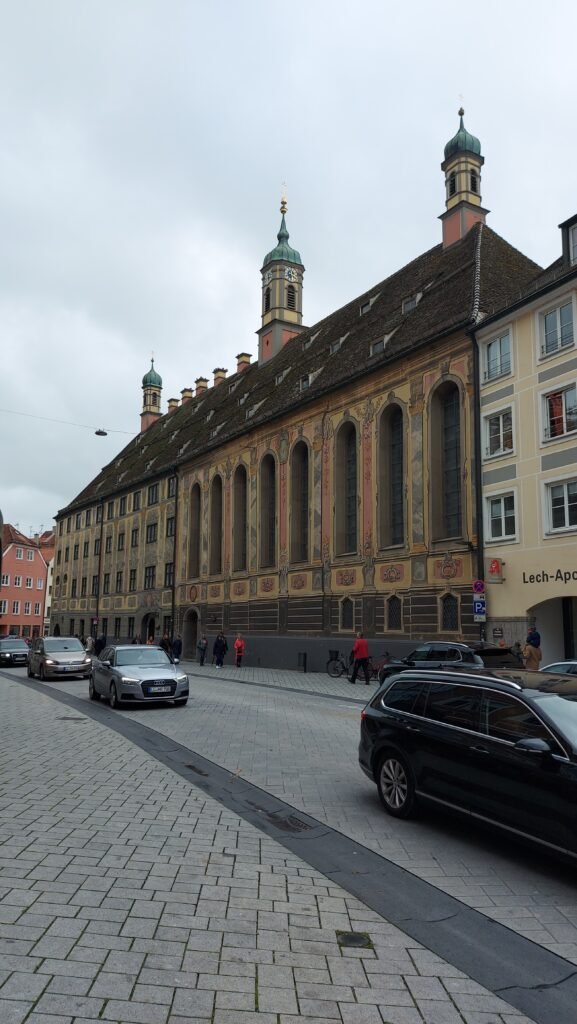
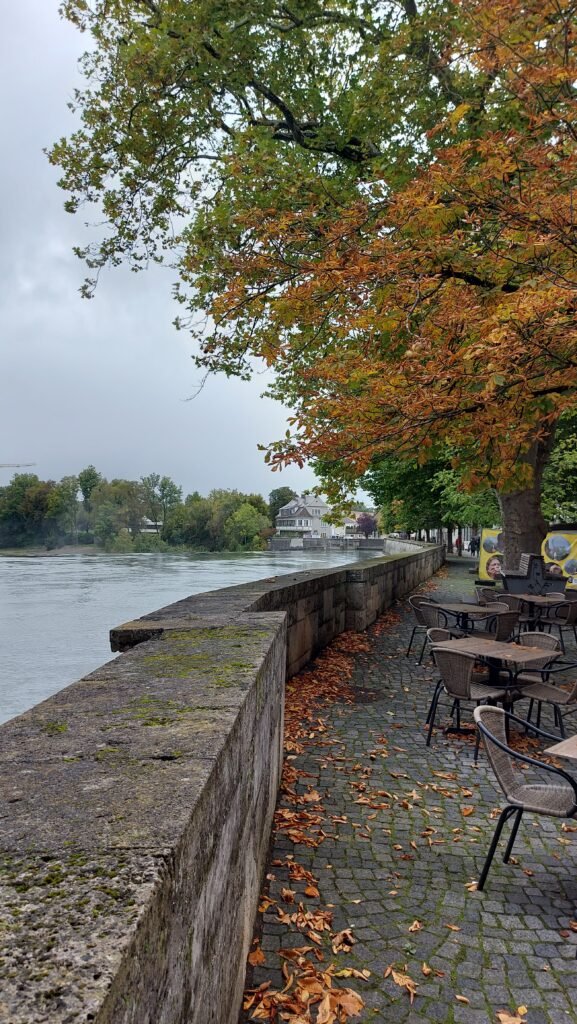
We had lunch, wandered about a bit more, and then headed back to the van just before a few more showers came on and that was the end of our day in Landsberg am Lech.
Sunday 29th of September
Landsberg am Lech
The decision was made to stay another day here as this is one of the prettiest towns we have visited, jam-packed with old buildings, towers from the 1400s and two incredibly ornate churches, the second of which we would stumble upon today. Another reason is that yesterday some of my pictures were taken under grey skies but today it is warm and sunny.

We decided to walk towards the town then take a pathway through the trees on the opposite side of the Lech to get a different perspective of the town and the weir. The force of water coming down the Lech was something to behold but there was no threat of flooding. The first building we encountered was the Mother Tower.
“Located directly on the Lech, the Mother Tower with its gold-colored roof is visible from afar in a park landscape. The historicist building, designed in the style of a Norman castle keep, was built in 1884 by Hubert von Herkomer in honor of his mother.
Born in 1849 near Landsberg, Herkomer later moved to England with his parents. There he received extensive training as a painter and was at the height of his fame as an internationally renowned portrait painter at the time the Mother Tower was built. The tower was built according to his own plans and today serves as a romantic backdrop for weddings, among other things.”
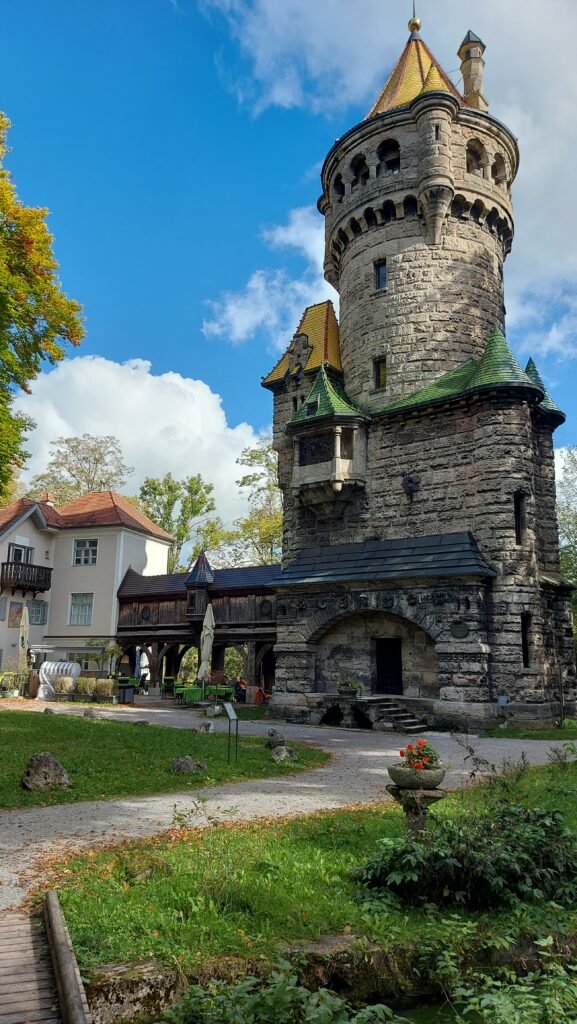
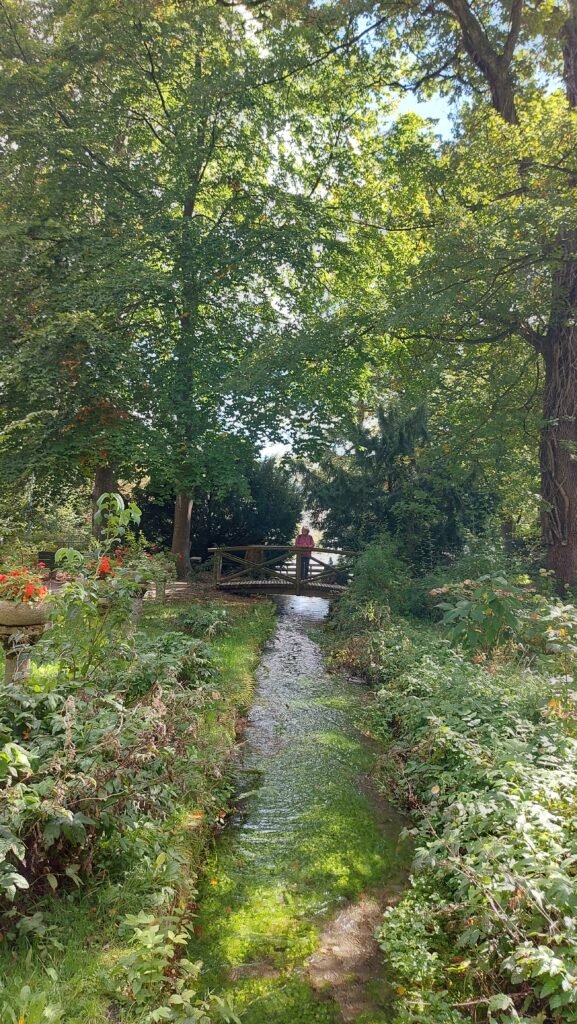

At this point a small stream flowed into the Lech through a garden and it was a very pretty area. Slightly further on you get a great view over the weir towards the town and its towers and brightly coloured houses. As we stood on the road bridge our weekly video call with the family happened and it was difficult to hear them due to the force of the water. In the calmer water under the bridge and before the weir huge trout could be seen swimming slowly about.
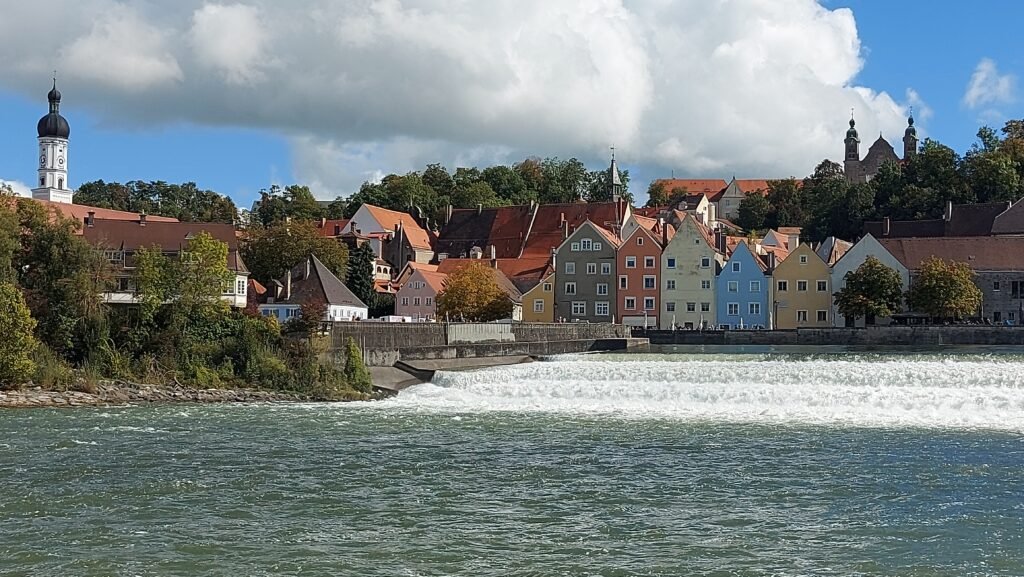
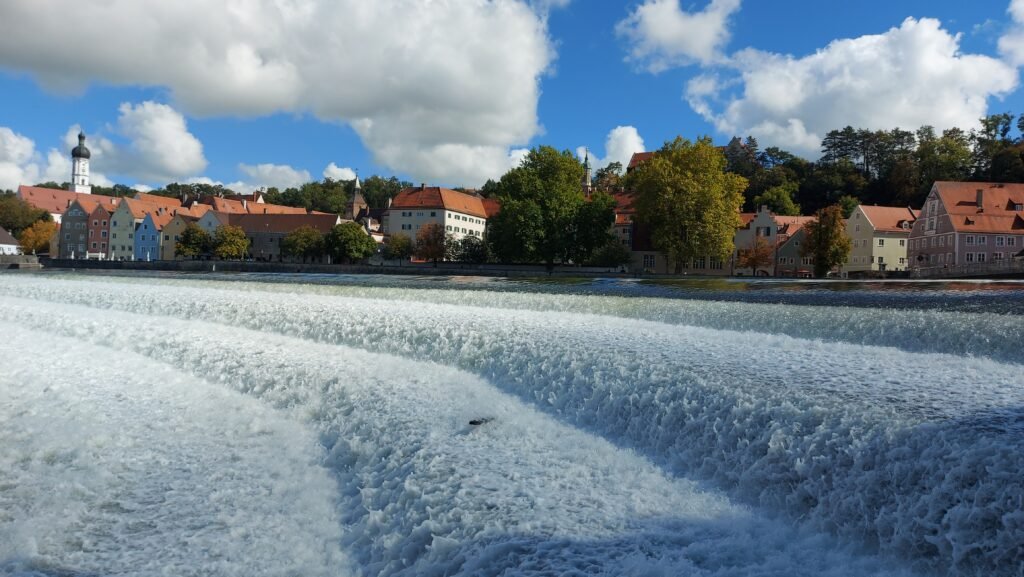
This being a Sunday with all the shops closed, I had hoped to take some pictures of the main street and square without any people in it to spoil the view but surprisingly the market we had seen yesterday was still on today. We wandered about some more then sat outside a bakery in the sun having our tea, coffee and cake while being entertained by some brass music. Very German.
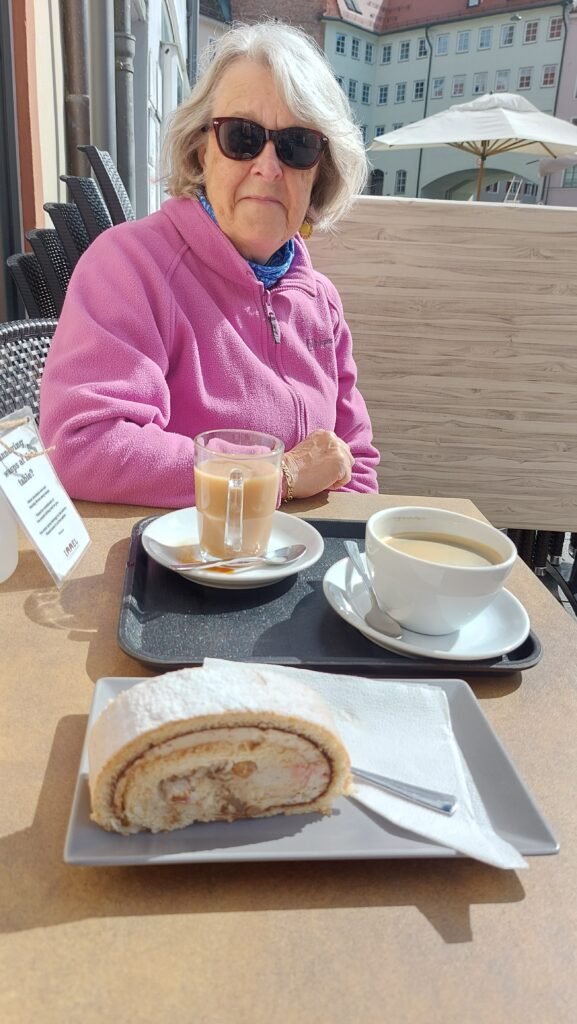
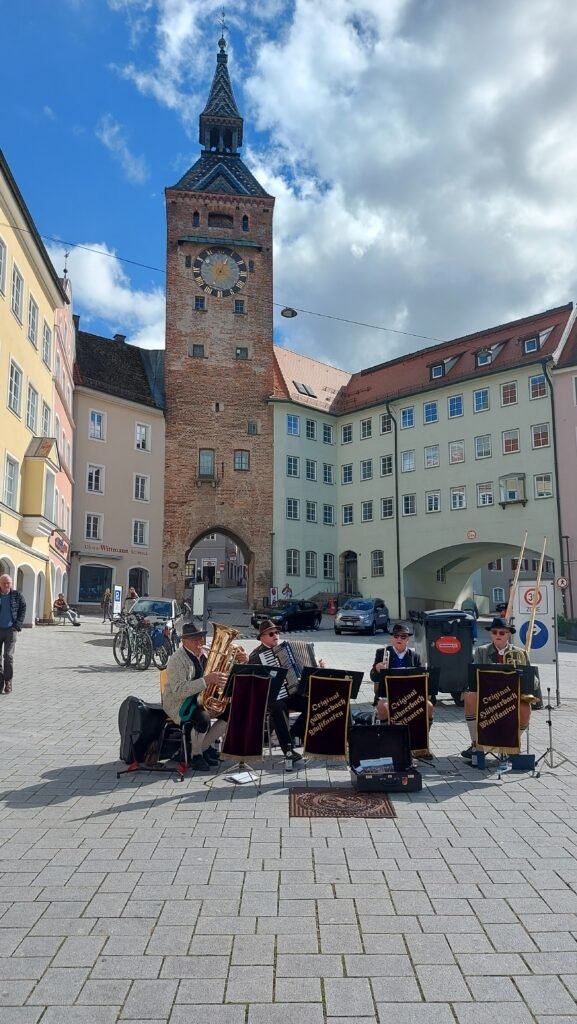
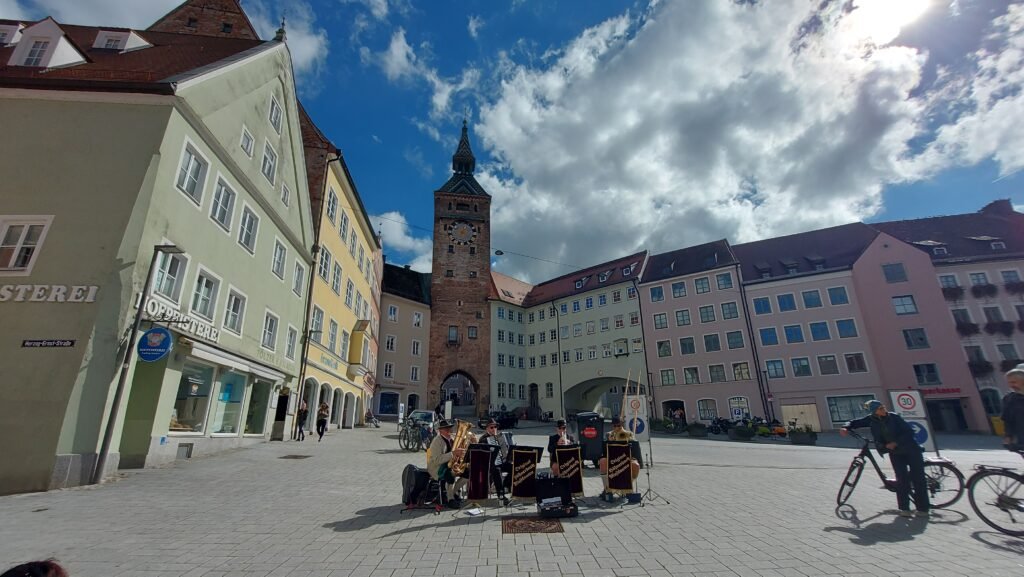
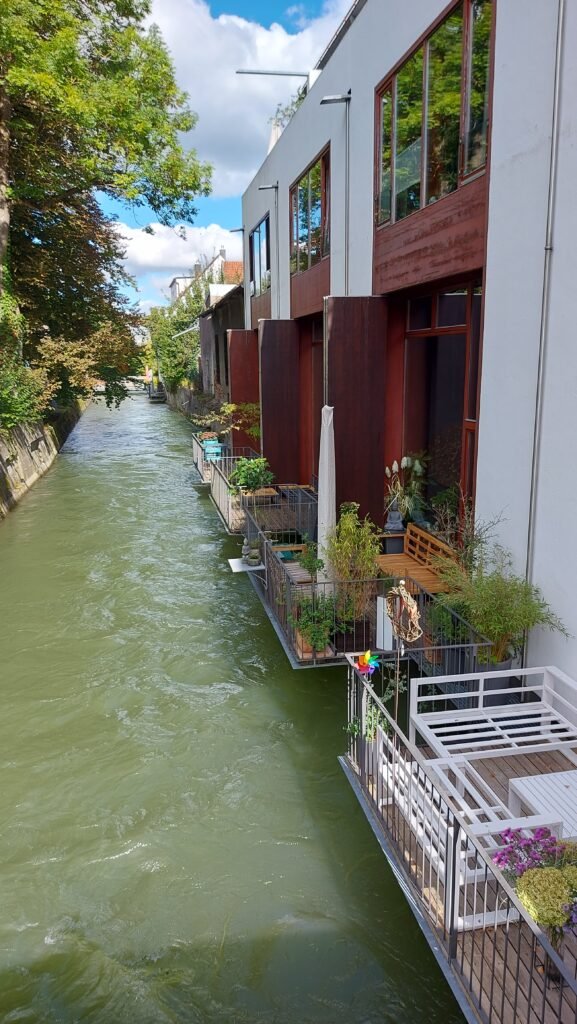


We found a bench outside the church we were in yesterday and listened to an elderly gentleman singing along to a hand cranked machine that plays tunes using sheet music. No idea what its called. He was obviously playing popular German songs as people were stopping to sing along and clap but few put money in his hat!
There was a van in front of us with a continual queue of about a dozen people buying all kinds of sausages in all kinds of bread, the most popular beind a foot long open baguette with onions and currywurst sauce. We took a few deviations to see some towers from the 1400s and stumbled upon yet another ornate little church.
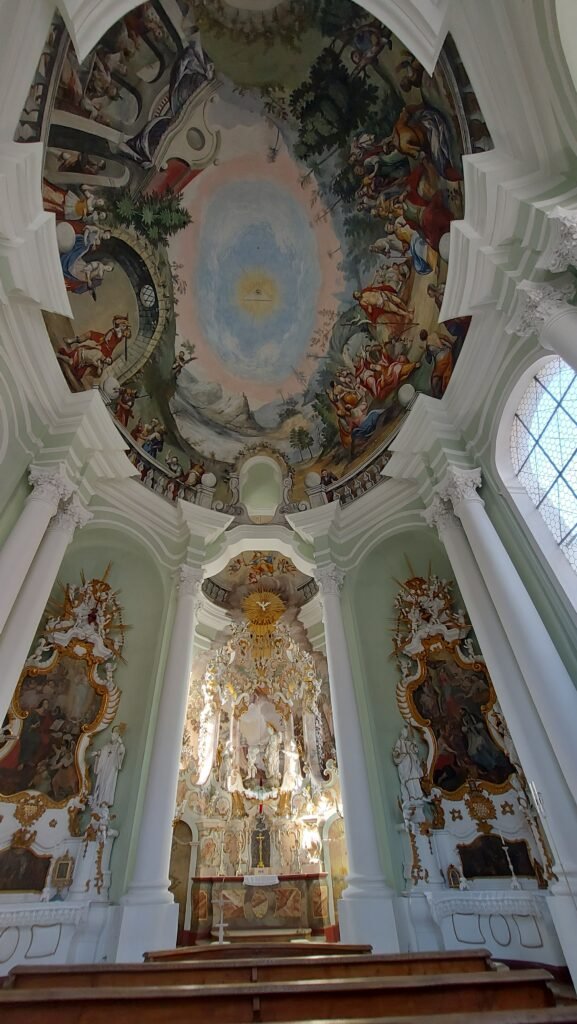


There is a display in part of the car park which explains the rise of National Socialism in German which in turn led to the Nazis taking over and we all know how that turned out! The text was translated into English and that is how I found out that Hitler met 330 people here when he was formulating and writing Mein Kampf in this beautiful town.
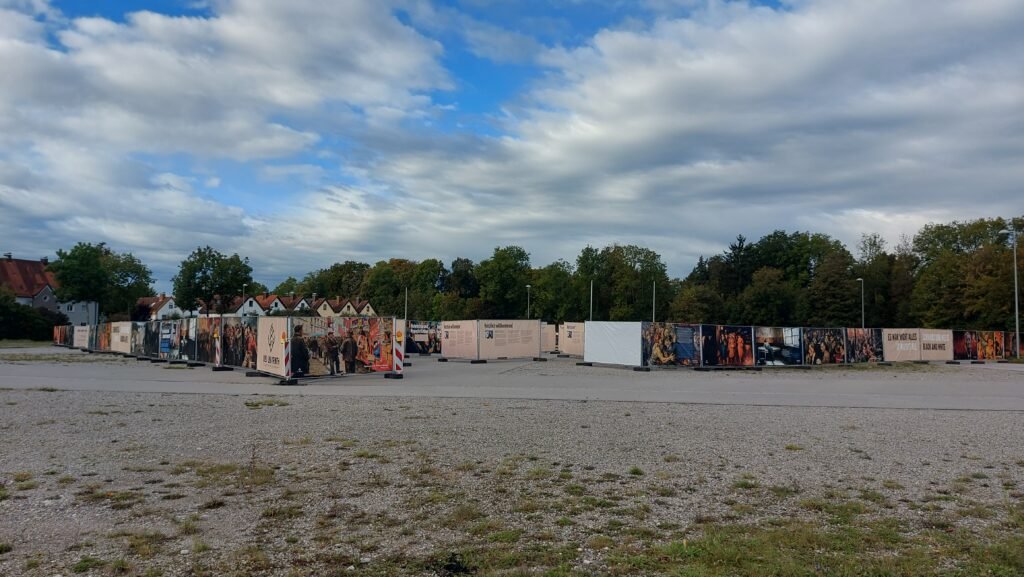
After dinner the heating went on as, when the sun starts to dip it starts to get airy. We can’t complain though as its been a lovely day.
Monday 30th of September
Landsberg am Lech to Friedberg (48.354413, 10.974371)
In the morning we serviced the van, paid our parking fee of € 10 (£ 8.35) for two nights and on top of that we had paid € 3 for electric and € 1 for water. Amazing value in a beautiful and historic town. Landsberg would turn out to be one of my favourite towns on the Romantic Road.
“Friedberg is a charming town in Bavaria, Germany, located just east of Augsburg. Founded in the 13th century, it has a rich history reflected in its well-preserved old town. The town’s landmark is Friedberg Castle, originally built as a defensive structure and later transformed into a Renaissance palace. The old town is filled with narrow streets, colorful facades, and traditional Bavarian architecture, creating a picturesque atmosphere.
Friedberg is also known for its historic watchmaking tradition. Its proximity to Augsburg and beautiful surroundings make it a peaceful yet culturally rich destination for visitors exploring Bavaria’s historic towns.”
After a straight drive up the A7 we found the Stellplatz in Friedberg without a problem. The online reviews said it was free to park here but there is now a parking meter and it’s € 10 (£ 8.35) a night which is still great value. It seems you pay for water and electricity but when I plugged in the electric cable we had power which I assume was from a previous van on this pitch.
We started this month in hot sunny weather and are ending it with chilly conditions with grey skies and intermittent rain showers. Just as we were set up the rain came lashing down so we had lunch with the hope it would clear up later. It did, but we went towards the centre in rain jackets and brollies at the ready.
Like Schongau a few days before, the Stellplatz is at the bottom of a steep hill with the town at the top of it, defended in the past with a city wall and a number of watch-towers which seem to be incorporated into houses now. The town was ravaged by the plague in 1599 and more suffering came as the town was sacked twice by the Swedes during the Thirty Years War. Yes Swedes, and I thought we were far travelled!
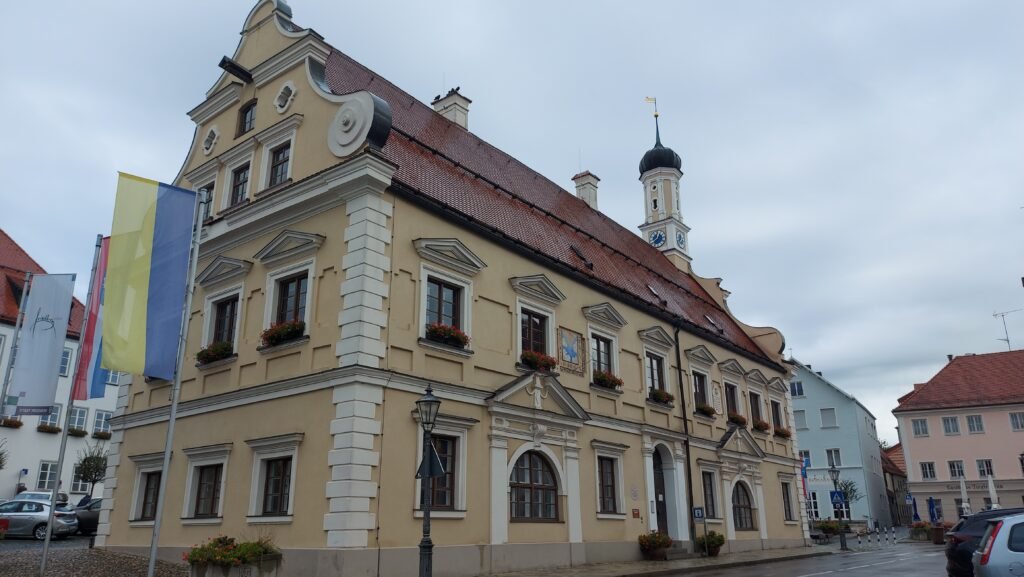
When you get to the top of the hill and enter the town centre the first significant building you see is the Rathaus (town hall) and an obligatory fountain, which are to be found in every single German town, sometimes quite a few in some towns. To be honest it didn’t get much more scenic or historic after that. It was a neat and tidy town, which is more or less a given in Bavaria, but we have seen better on our travels.
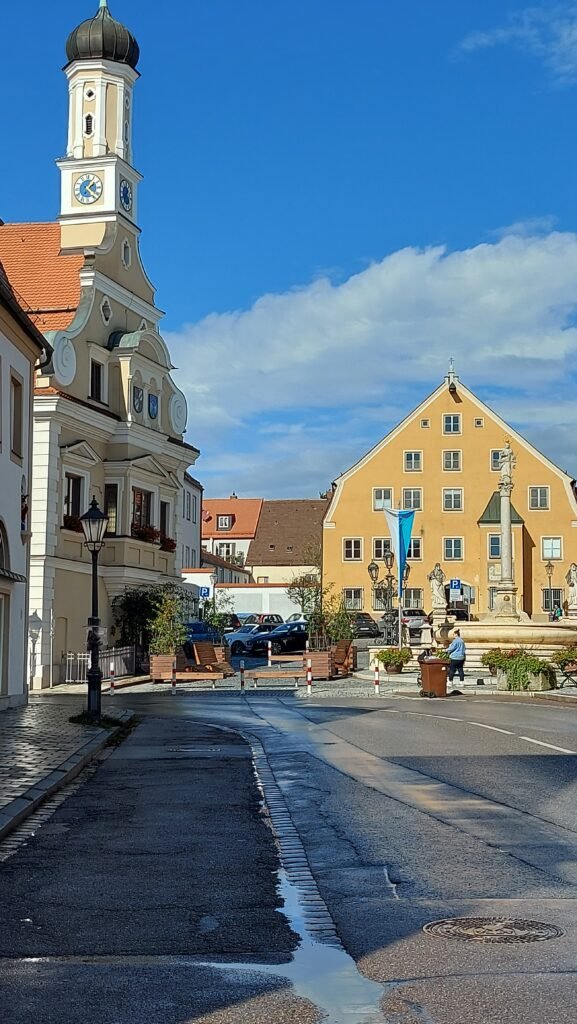




On the way back down the hill we popped into a Lidl for a few things including a bottle of wine that we enjoyed recently and wanted to buy another, just to be sure before buying a case or two. Today it was reported that our crazy SNP Scottish Government has increased the minimum unit pricing on alcohol and it is feared that a standard bottle of wine will cost at least £ 6 in a supermarket.
On all of our past foreign excursions we have always brought back the maximum allowance of 48 bottles of wine (for two people) and this time will be no exception. I should mention that our daughters always get six bottles each…
Tuesday 1st of October
Friedberg to Augsburg (by train)
We crossed from Harwich to the Hook of Holland on the 1st of September and here we are a month later about to embark on our second month in Germany. To be honest I am glad I am writing this blog as we have been to do many wonderful places and that it would be easy to forget the place names and what we did there. To prove this point we discussed a place today we had been to in the past month and we had no idea what it was called!
Friedberg and Augsburg are only a few miles apart and today the plan had been to move the very short distance to Augsburg but, for a few reasons, we decided to stay on this Stellplatz and take the train into Augsburg.
Augsburg is the third largest city in Bavaria after Munich and Nuremberg and is large enough to host a Bundesliga team (currently 15th) and from where we are it is a twelve minute walk to the station and for € 7.60 (£ 6.35) we were transported on a shiny new train into the centre of Augsburg. There were two couples sitting in front of us in full Bavarian costumes for both sexes and the men were drinking bottled beer at 10.30am something you could never do on a Scottish train as the punishment north of the Border is a maximum fine of £ 1,000. We assumed they were travelling on to the Munich Beer Festival.
“Augsburg is one of Germany’s oldest cities, located in Bavaria along the Romantic Road. Founded by the Romans over 2,000 years ago, it boasts a rich history and impressive architecture. The city is famous for its Renaissance town hall, the majestic Augsburg Cathedral, and the Fuggerei, the world’s oldest social housing complex. Augsburg’s picturesque streets are lined with colorful buildings, charming squares, and historical fountains, such as the Augustus Fountain. A hub for culture and the arts, the city offers museums, theaters, and festivals. Its blend of history, culture, and vibrant atmosphere makes Augsburg a captivating destination.”
Coming out of the station your first impression is of a city with wide streets and not a lot of traffic, maybe because it has a low emission zone, another reason for not coming in Otto. The thing that you always notice as well is the complete lack of litter in a German town or city and Augsburg was no exception.
The bombing of Augsburg in World War II included two British RAF and one USAAF bombing raids against the city on 17 April 1942 and 25/26 February 1944, the first to bomb the the MAN U-boat diesel engine factory at Augsburg and the second to bomb the Augsburg Messerschmitt works and a huge part of the city centre was destroyed as well. The city today does give the impression that most of the buildings have been built or rebuilt since the war.

As we were walking about we found an area of indoor and outdoor food stalls (mostly indoors) and The Navigator had her morning coffee and I had a glass of Riesling, well, when in Germany!

Even although it still wasn’t noon, another indoor building had busy food stalls on either side of the hall with benches in the middle to sit at and eat your meal or snack. We thought if we didn’t see anything better on our walkabout we would return later and eat here.

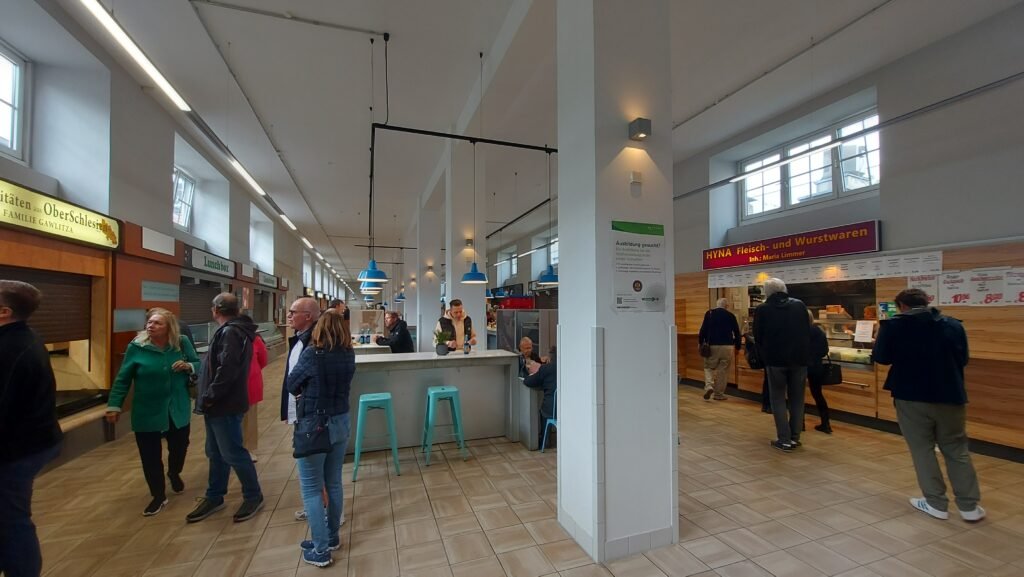
About half an hour later we came to the main square in front of the Augsburg Town Hall, or Rathaus as they say in these parts, is the administrative centre of Augsburg, and one of the most significant secular buildings of the Renaissance style north of the Alps. It was designed and built by Elias Holl, Stadtbaumeister, in 1615–1624. Due to its historic and cultural importance, it is protected by the Hague Convention for the Protection of Cultural Property in the Event of Armed Conflict.
Who knew there was such a convention?
The view of the Rathaus was almost completely blocked by the stock exchange building built in 1828, until British bombing on the night of 25 February 1944 destroyed the latter. The removal of the remains of the stock exchange in the 1960s finally made it possible to view the Rathaus properly from the town square.
Next to the Rathaus is the 70-metre-tall Perlachturm, a belltower in front of the church of St. Peter am Perlach and it originated as a watchtower in the 10th century. The existing Renaissance structure was built in the 1610s by Elias Holl.
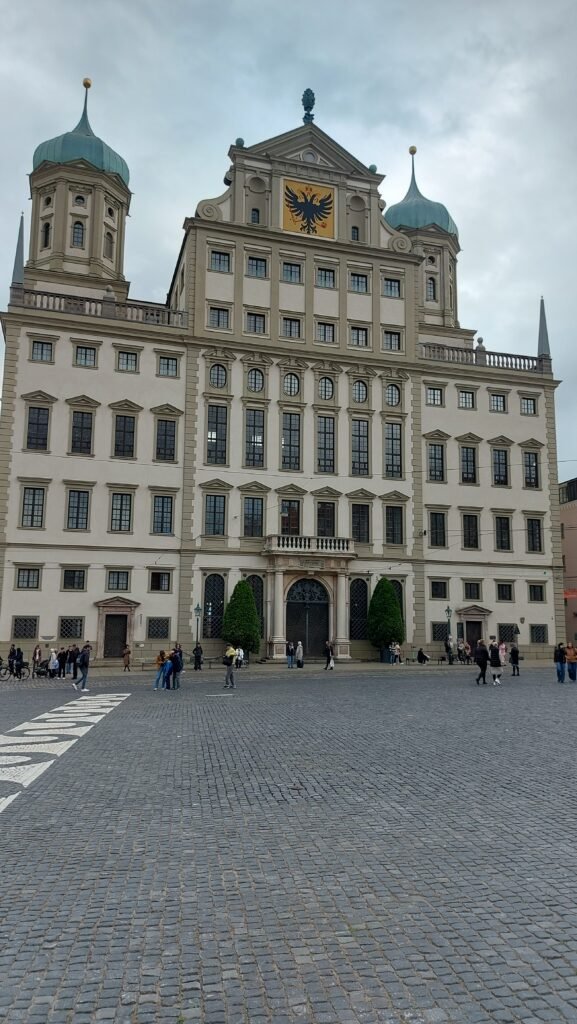

Again we’ve seen better town squares, but at least these two structures give some history to the city.
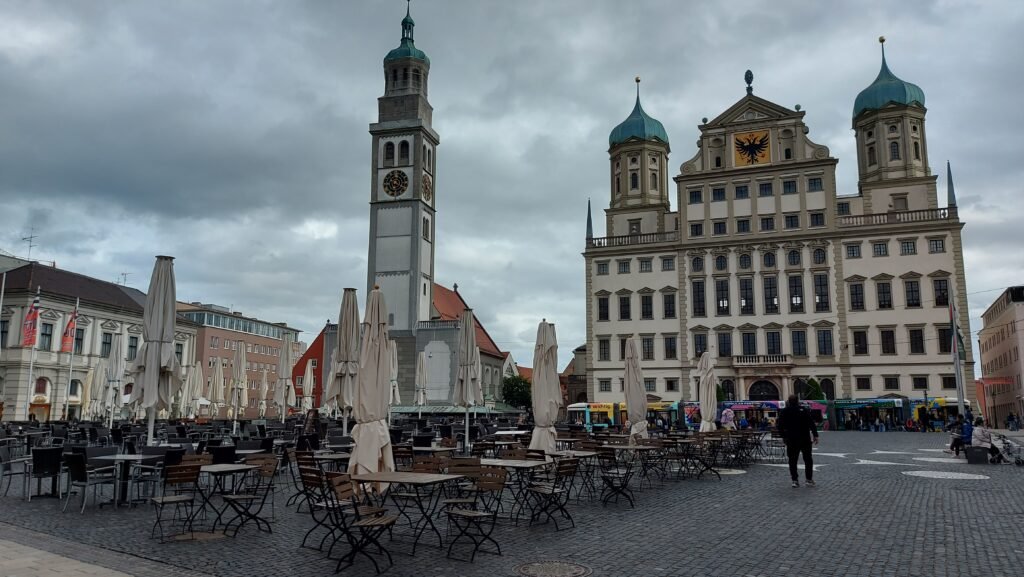
Before we visit anywhere we watch some YouTube videos to get an idea of what to see and do in the limited time we have there and it was on one of these videos that we saw the presenter have lunch which was said to be a favourite local speciality, Hausgemachte Käsespätzle. There was a tourist information office on the main square and I showed someone the YouTube video and asked him what it was, as on the video the name was indistinct. He not only told me what it was but said if I went through a nearby archway the very restaurant in the video was just there.

The Navigator has expressed a wish on a few occasions that she would like a sit down knife and fork regional dish and since seeing the video, this was to be the one. The dish seemed to be a pimped up version of macaroni cheese, which she loves and I don’t! The restaurant was packed, always a good sign, and we had to go upstairs to get a table, shared with another couple.
To me it was indeed a pimped up macaroni, only with Swiss stringy cheese and topped off with crispy fried onions accompanied with a side salad and two chilled glasses of Riesling. To be fair, it was delicious, but I wouldn’t order it again if that makes sense as the menu had carniverous options which I would have preferred. That said, it ticked all The Navigator’s boxes so mission accomplished…
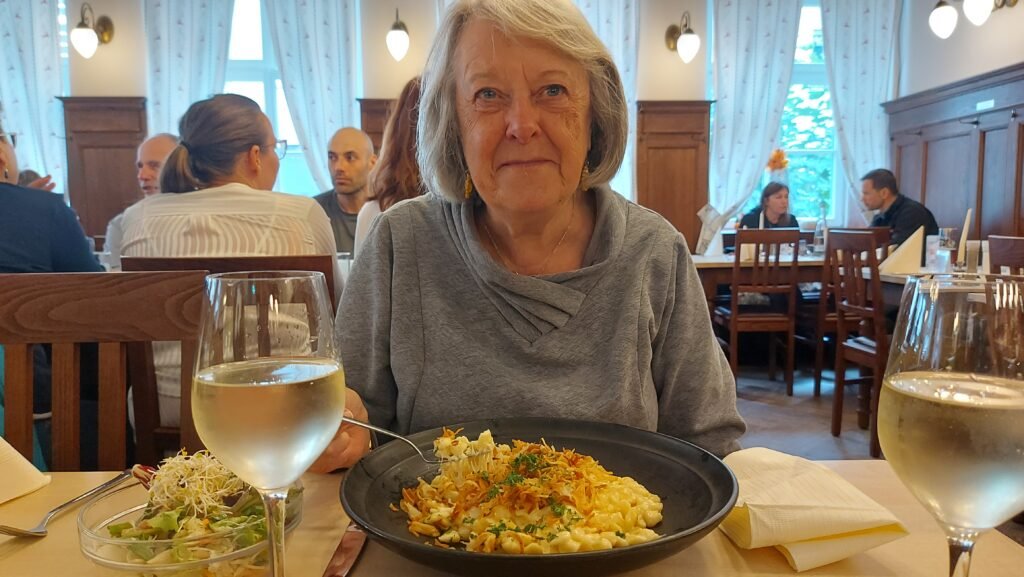
We continued our walkabout and found the Dom (cathedral) which was an imposing building but no where near as opulently decorated as other churches and cathedrals we’ve seen.


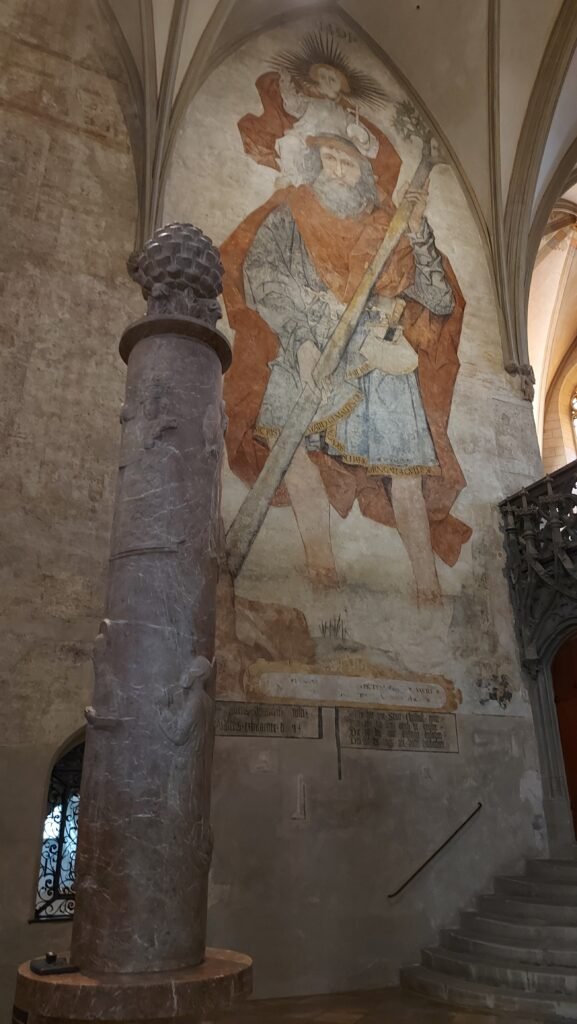
By this time it was mid afternoon and we headed back in the direction of the station but were ambushed by another Tchibo so we had tea, but no cake this time as we were still full after lunch.


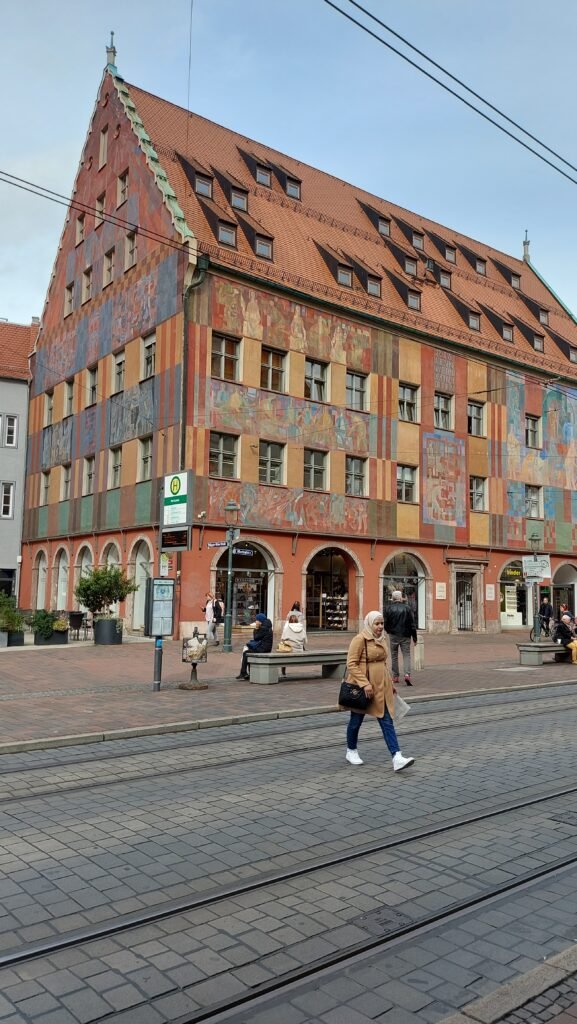
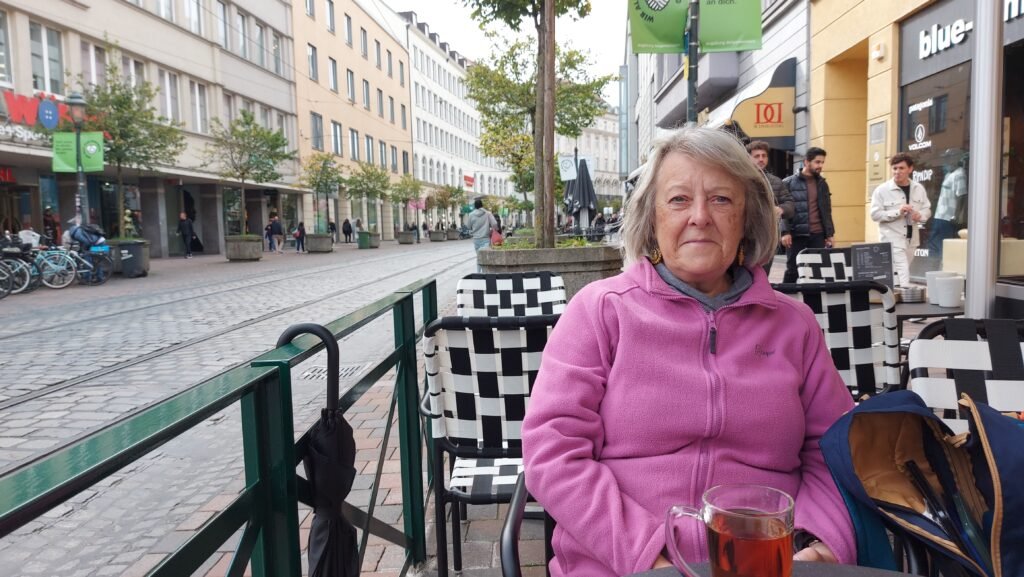
We had to wait half an hour for our train and were fascinated to see the long distance bullet type trains pulling in and departing on time for places like Hamburg and Munich.
Back at the Stellplatz another British van had just arrived but they were faffing about trying to decide which pitch to take so we left them to it and went into Otto and I duly fell asleep. Later in the evening the rain came on quite heavily but at least it had been dry for our day in Augsburg.
COMING SOON ON THE NEXT BLOG…
The next blog will see us driving further north on the Romantic Road in Germany with every destination new to us, which should be fascinating.
PS. Spoiler alert. It is…
Stay tuned, and if you are not already SUBSCRIBED to these blog posts, then use the subscription form to sign up to be notified of the new blogs when they go online.
To read the first blog in this series – CLICK HERE
To read the second blog in this series – CLICK HERE
To read the third blog in this series – CLICK HERE
This is the fourth blog in this series
